Interview with Nils Melzer about his book - The Persecution of Julian Assange
 Chris Hedges discusses ‘The Trial of Julian Assange,’ a new book by Nils Melzer, UN special rapporteur on torture, in this edition of Hedges show, On Contact.
Chris Hedges discusses ‘The Trial of Julian Assange,’ a new book by Nils Melzer, UN special rapporteur on torture, in this edition of Hedges show, On Contact.
 Chris Hedges discusses ‘The Trial of Julian Assange,’ a new book by Nils Melzer, UN special rapporteur on torture, in this edition of Hedges show, On Contact.
Chris Hedges discusses ‘The Trial of Julian Assange,’ a new book by Nils Melzer, UN special rapporteur on torture, in this edition of Hedges show, On Contact.


 It's not an easy life described within the covers of Donna Ward's semi-autobiography, She I dare not name: A spinster’s meditations on life, Allen and Unwin, NSW, 2020. In a vocabulary measured with precision but rich with imagery, Ward evaluates her experiences as an unmarried woman who achieved this status without wanting it at all. The book is very honest in its descriptions of how this came about and the importance that it has in defining the course of Donna’s life. The term "spinster," is initially called up like some daemonic creature. It is something she almost dare not name! As we read on, we realise that spinsters are not gothic inventions, but human like their married counterparts, probably equally defined by hazard.
It's not an easy life described within the covers of Donna Ward's semi-autobiography, She I dare not name: A spinster’s meditations on life, Allen and Unwin, NSW, 2020. In a vocabulary measured with precision but rich with imagery, Ward evaluates her experiences as an unmarried woman who achieved this status without wanting it at all. The book is very honest in its descriptions of how this came about and the importance that it has in defining the course of Donna’s life. The term "spinster," is initially called up like some daemonic creature. It is something she almost dare not name! As we read on, we realise that spinsters are not gothic inventions, but human like their married counterparts, probably equally defined by hazard.
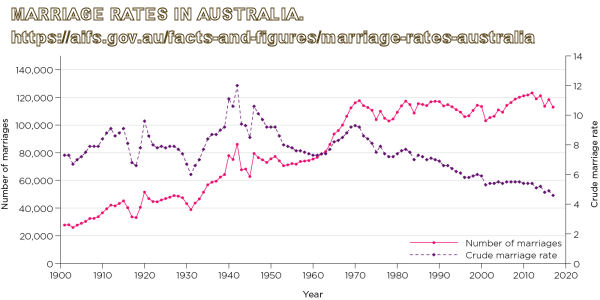
It seems to be a case of pot luck that brought Donna to the point of which she writes, in a book finished in her sixty-seventh year.
Donna describes early years rich in experience of nature and travel, warm relationships with larger-than-life parents, and the birth of a young sister in her early childhood. This was however an event notified by her father, only one day prior, with something like sexual shame.
“He said this as if he barely understood anything about it , as if it was something Camille and Mum had cooked up between themselves that very day , something so shameful he’d had to fly all the way home to sort it out, though I didn’t think he was doing a good job of it.”
Mostly, however, her account of her childhood reads almost like a comforting and exciting slide show with non-sequential images and vignettes, depicting mostly carefree recollections. One senses though, that Donna’s parents are involved with each other more than they are with Donna, and that their relationship with her has conditions attached. In primary school, Donna experiences a “desperate relationship with spelling and arithmetic,” to the extent that she is sent to a psychiatrist. No-one can determine whether she is “brilliant or dumb.” Her mother cannot hide her shame from Donna. By the time Donna is ten, though, she is a good student.
It's in adulthood that the going gets really tough. Donna also indicates that she has a very poor relationship with her sister. Where she might have expected to benefit socially in many ways, from an introduction into her parents' well-connected circle in WA mining world, instead, having chosen to do social-work, she is marked as an outsider.
Ward moves from Perth, Western Australia, to Melbourne, Victoria, as a young woman, and predictably has to make her own way in the big city. She shares houses but mostly lives alone. She goes to university and gains her degree. She lands her ‘dream job’ but loses it to a male in the ‘recession we had to have’, as it was termed by the then Federal Treasurer Paul Keating, in 1990.
This job-loss was probably a defining point in Donna’s personal development. Where professional status might have compensated an early lack of unconditional love and brought her earning capacity and social rank up to something recognisable to her former peers, her job-loss plunges her into indeterminate socio-economic status. In parallel with other isolated social and economic victims of economic rationalism, she must individually craft a new survival path. She achieves this with difficulty, an exotic traveller in the new age, finally emerging as a neo-classical philosopher on non-marriage.
Descriptions of her social encounters give the reader a sense of her tumbling around in a sea of strangers interspersed with special friends and lovers poetically anonymised for publication as archetypes or as characters in Ancient Greek tales. Our heroine or protagonist does her best with what she encounters. The life she grapples with is one that has no markers or guideposts and she feels herself to be at the mercy of the preferences of the males she becomes involved with, or the narrative they see for their lives, with respect to other female players. Then again, it was she who decided not to go through with marriage to a Japanese fiancé. In her chapter, ‘The Weight of a child’, we glimpse another of life’s cul-de-sacs as she briefly recollects terminating a pregnancy that resulted from rape.
“I could not have that child, the conception had been so rude. The way his father pushed me onto the couch, held me at the throat, tore my panties and took his revenge, took what I had denied him years before. […] In the autumn of 1977, when the jacarandas were yellowing and the plum trees sapping their leaves, I let that child go, lest I be tied to his father for the rest of my life. I believed another child would come along. (Ward, Donna. She I Dare Not Name: A spinster's meditations on life (pp. 248-249.)
No-one seems to be looking out for Donna, our heroine. She just has to take it on the chin. Is this a failing of her character or is it due to the milieu and time she finds herself in? We found her a very likeable character. In many ways we were reminded of our own photogenic childhoods with happy pictorial vignettes bathed in yellow light, freedom, and cosiness, along with similar struggles in adulthood.
This narrative raises the question: How does a young woman in a big city, away from her parents and her natal community, find love, or find that suitable person with whom to form a family? It is clear from Ward's writing that that her drive to ‘nest’, to be part of a couple (duo), and to have a child, is very strong. It seems both hormonal and social. She wants to be part of the world of couples, to alleviate loneliness, to find security, and to change her status. In the face of disappointment, she soldiers on courageously, but her essentially solitary situation – despite friends and jobs - makes her vulnerable to predatory or incompetent approaches.
She mentions serial recoveries from the emotional hurt of broken relationships. Is life really meant to be so hurtful and stressful? Many women and men would relate to the bruising nature of the relationship-seeking process in the 20th and 21st century urban social environment.
The author describes her experiences, starting in the 1970s until the present. Dating is one way we do this in the West. Both parties do a series of interviews over dinner and this process can go on for years. There are more casual opportunities in which to evaluate potential partners, such as clubs with shared activities, like tennis, bushwalking, or Meetups; churches, political groups, universities, and work. A friend of mine met her life-partner and husband through an ad in a ‘singles magazine’ in the 1980s. These days she might have found him via internet dating services.
The quest for a mate is not a level playing field between men and women if they want children, as the woman is almost invariably up against time constraints. These constraints become increasingly urgent as she moves from her twenties to her thirties. A woman has a brief period in her life from about age sixteen to twenty-five, when she is most sought after by men her own age as well as those considerably older. In terms of sexual attractiveness, she has the odds in her favour then, more than she will have at any time in the future.
If she misses this opportunity to light on the ideal partner, or at least a suitable one, she has her work cut out. It will dawn on her gradually, as she approaches thirty, that really there is not much time and there is a decreasing number of men to choose from.
The finishing post in this ‘race’ is usually considered to be forty, after which a woman will not necessarily expect to ever conceive. If she wants to and she does, it will be a bonus in any permanent partnership she manages to secure.
The woman is, as was Donna Ward, expected, under this pressure, to make a wise assessment of the men who cross her path, to get to know them better than superficially, and to try not to get hurt. Whether she will have descendants depends on how she negotiates this situation. Adding to the difficulty of the task, in her most propitious years, she is necessarily young and inexperienced.
How could our society better provide a benign environment for young marriageable people to meet in relative safety? Should mothers give guidelines to their daughters as to how to as to how to negotiate the situations they will face? Did most mothers also have to just find their way through the minefield? Did they think, "Well I had to do it, and my daughter now faces the same challenge!"
Do most of us leave this all-important decision to complete chance? The writers' parent’s generation, reaching adulthood in the 1940s, were more connected, and their parents more so. They did not often travel far or without introductions. They grew up in more predictable communities with pathways to identifiable milestones (rites of passage) and traditions, and relatives and connections, for negotiating these. At the same time, in the Anglosphere and Europe, in the 1950s and 60s, a burgeoning manufacturing industry meant plentiful jobs. An explosion in energy resources and transport allowed people to commute by car to work, from affordable housing in new estates on land once out of reach. That meant more people could move out of home, get a job, and get married. It was called the Baby Boom. Unfortunately, the explosion just kept magnifying and accelerating globally until mass transport and travel broke time-worn connections, dispersing people, at ever increasing speed to the four winds, far away from the familiar pathways, milestones and traditions.
Thus, our heroine dispersed like a dandelion seed and landed in Melbourne, apparently without any significant connections, in a city with diminishing social capital.
Did most women of her generation negotiate the getting hitched and having children part successfully - if not forever or until ‘death us do part’ - at least for long enough to have a child or two? Why did some, like our heroine miss out, or was the experience more common than we may think? Good luck finding statistics on how many women die without having children. As you can see from the graph, the unmarried proportion of the population has been steadily increasing since the 1970s oil-shock.
Maybe those who did not partner for long enough to have at least one child lacked the connections to find a suitable partner. This seems to be the case with Ms Ward. Many of her encounters with men seem accidental, lacking formal introduction or context, and so she lacks essential information. In assuming reciprocally honest interactions, she is fooled, more than once, by men who are thus easily able to conceal the fact that they are already partnered. Positive tit-for-tat, where good deeds and bad deeds are quickly reciprocated is only possible in viscous societies, where people stay close to where they originate from. Melbourne’s population is close to thirty-five per cent diaspora. Another way of saying this is that people can get away with breaking trust in an anonymous or constantly changing population, unless they belong to a stable enclave within it. Donna didn’t.
A major part of Ms Ward's serial emotional recoveries from serial romantic disappointments come from the blow to her self-esteem, because she mistakenly believes that there must be some flaw in herself, invisible to her, but which these men can see.
A more informed perspective might explain, however, that Ms Ward is a stranger trying to make her way in foreign territory, where her pedigree is unknown, where she has little or no personal status. She does not read the signs accurately or speak the local social language fluently. She is proceeding using signs she learned in West Australia for a small network there, which has probably gone extinct. She did not avail herself of that network when she was in West Australia because she had different values from her parents. This was because she came from a different generation at a time when values were changing rapidly. In her case, Aboriginal rights and Germaine Greer were (by her account) two contemporary changes that obviously influenced her and helped to separate her from her origins. The first affected her relationship with her mining father, and the second affected her relationship with men more generally.
Apparently, she did not want to be part of the money and status oriented, environmentally exploitative, mining crowd her parents belonged to. So, she migrated from West Australia to Sydney, then Melbourne. She acquired some social credentials and connections from universities there, but they were not enough to establish her as a local candidate for the kind of marriage she wanted. She found a good job, but the 2008 recession removed that job, so what were her prospects? We don't know. Having a house is certainly a plus, if you want to attract a mate, but, although she seems to have a house, we do not know how big her mortgage is. She would have needed to be careful not to marry someone with lesser prospects, for fear of being impoverished by divorce, and that would rule out a large and growing demographic.
Ms Ward seems to assume that marriage must have its basis in love. Most people want to marry up and for love, and most who marry say they did marry for love, but how many really do? Is the number of divorces an indication?
Since Ms Ward seemed to have limited opportunities, for one reason or another, perhaps she could have ranked her priorities differently. Reading closely, her real priorities might have been marital status, children, and companionship. Unfortunately, she seemed to put love up at the top. Love is a western ideal but, unless you are very lucky, that is a musical chair game that leaves many more standing than seated, and childless if they persist as the stakes go up. It might be better to look for respect and kindness. Love might come later, and, if it doesn't, affairs within marriage are the tried and true solution.
It is easier to understand the problem of partnership in the west, if you imagine that you are arranging a marriage for someone in 19th century England or in 20th century India, where your parents work out early where you are situated with regard to income expectations and earning, education, charm, and physical attributes. Although your parents might use marriage brokers, it is still likely that they will employ those brokers to find someone within their circle, or at least within a similar circle. When they find a candidate, each set of parents checks the other out for compatibility. After that they decide whether or not to let the children meet.
Given that parents do not generally perform this role as explicitly in contemporary Western society, many young women have to fend for themselves. Perhaps a way women (and men) could try to look after their own interests better could be by cultivating a perspective as if they were their own in loco parentis. Such a perspective would indicate a major change in the concept of marriage in Australia.
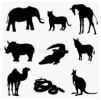 The Prevention of Cruelty to Animals (POCTA) Regulations 2008 sunset on 15 December 2019. New regulations need to be made before this date.
The Prevention of Cruelty to Animals (POCTA) Regulations 2008 sunset on 15 December 2019. New regulations need to be made before this date.
Following a thorough review of existing regulations and extensive consultation with a range of stakeholders, the Victorian Government has developed the proposed POCTA Regulations 2019 and associated Regulatory Impact Statement (RIS). These documents are now available for public comment.
The POCTA Regulations 2019 aim to protect the welfare of animals in Victoria by supporting requirements set under Victoria’s primary piece of animal welfare legislation – the Prevention of Cruelty to Animals Act 1986.
This is achieved by preventing, or minimising, harm through regulation of specific activities.
The RIS examines the costs and benefits of the proposed POCTA Regulations 2019 and considers possible alternatives.
New or amended regulations include:
· Animal transportation and tethering requirements
· Use of pain relief for mulesing
· Sale and use of wildlife safe fruit netting
· Sale and use of electronic devices
· Approvals and other processes related to the use of traps
· Operational and administrative processes for Rod Scientific Procedure record-keeping, the sourcing of animals, and training of Animal Ethics Committee members
· Fees
You are encouraged to contribute your views, expertise or ideas on the draft proposed regulations and options presented in the Regulatory Impact Statement. Consultation is open until midnight on Thursday 26 September 2019.
Copies of the RIS and the proposed regulations may be obtained from the Engage Victoria website at https://engage.vic.gov.au/prevention-cruelty-animals-draft-regulations-2019
The Engage Victoria website is the preferred method for receiving submissions.
Please note that all comments and submissions received will be treated as public documents.
Thank you and regards
 Move aside Steven King, jellyfish are worse than any of your demons, worse than any Grade-B monster that’s graced the silver screen. Unlike The Blob, which can be stopped by freezing, you can’t kill them. Not with chemical repellents or biocides or nets or electric shocks or introducing species that eat jellyfish like the striped sea slug. If you shoot, stab, slash, or chop off part of a jellyfish, it can regenerate lost body parts within two days. Not even the past 5 major extinction events which killed up to 90% of all life on earth, killed off the jellyfish.
Move aside Steven King, jellyfish are worse than any of your demons, worse than any Grade-B monster that’s graced the silver screen. Unlike The Blob, which can be stopped by freezing, you can’t kill them. Not with chemical repellents or biocides or nets or electric shocks or introducing species that eat jellyfish like the striped sea slug. If you shoot, stab, slash, or chop off part of a jellyfish, it can regenerate lost body parts within two days. Not even the past 5 major extinction events which killed up to 90% of all life on earth, killed off the jellyfish.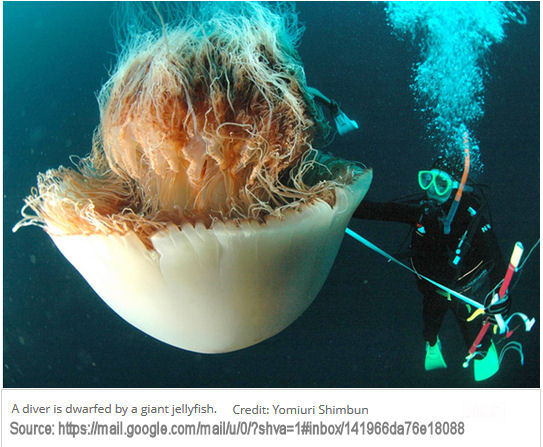 Meanwhile they’re on a rampage, doing millions of dollars in damage clogging intakes of nuclear, coal, and desalination plants, killing millions of farmed fish, and destroying fishing nets with their sticky icky bodies.
Meanwhile they’re on a rampage, doing millions of dollars in damage clogging intakes of nuclear, coal, and desalination plants, killing millions of farmed fish, and destroying fishing nets with their sticky icky bodies.
The more we overfish, pollute, acidify and warm the ocean, create vast dead zones, and trawl ocean bottoms, the better the jellyfish do.
The oceans make the earth habitable for us. They generate most of the oxygen we breathe, stabilize temperatures, drive climate and weather, and absorb a third of the CO2 we’re emitting. Over 3 billion people depend on the oceans for their livelihoods; 2.6 billion depend on seafood as their main source of protein.
Most alarming of all, 40% of phytoplankton has died off globally since the 1950s – they’re not only at the base of the food chain, but they generate most of the oxygen we breathe, as well as absorb half of the carbon dioxide, and their increasing death rate will make the ocean get warmer even faster.
They’ve everywhere, spread around the world in ship ballast or sea currents.
Ubiquitous – from top to bottom of the ocean, from pole to pole, year-round.
Grow faster than other species to quickly take advantage of any food, and they’ll eat almost anything — copepods, fish eggs, larvae, flagellates. They eat past when they can keep consuming, spit food out, waste a great deal other creatures could have eaten. Even when they’re full, their tentacles keep capturing prey.
If there’s no food, jellyfish can consume their own body mass and get smaller and smaller until they find food again, and rapidly return to normal. Even when they grow smaller they can still reproduce.
Consume many times their body weight in high-value food but are of low-value themselves because they provide little energy, ounce for ounce, compared to the food they ate. So they have few predators.
When 2 weeks old they can lay 10,000 eggs a day that hatch 12-20 hours later
They reproduce many ways: massive orgies, fission, fusion, cloning, hermaphroditism, external fertilization, self-fertilization, copulation.
If they lose a body part, they can regenerate it within 2 days.
They are the “Last Man Standing” in eutrophication zones because they need less oxygen
Many species can tolerate any salinity level, from fresh water to salt water
They’ve survived ice ages, hothouse climates, all five mass extinctions, predators, competitors, and us.
Jellyfish in the oceans have been known to live over 10 years
Many of them avoid predators by long vertical migrations from the deep sea to the surface at night and back down again by daylight
Just as plants have seeds which can endure many years waiting for optimum conditions to grow, jellyfish have a seed-like state called a polyp that waits for good conditions, and can clone themselves to create armies of ‘seeds’ waiting to burst into jellyfish blooms seemingly overnight. Polyps don’t “grow up” to become jellyfish. They spawn what we think of as jellyfish – the medusa — which then mate sexually to produce polyps, which stick to rocks, shells, man-made structures, plastic, etc. Both the polyps and the medusa could be considered “immortal” – when a polyp dies it’s clones live on, and there is one species of jellyfish, where after it dies, its pieces turn back into polyps (“Logically, it would seem that other species probably do it too, but we have yet to identify others,” according to Gershwin in a reply to this book review).
That seems so wrong– a primitive brainless blob? But jellyfish eat much larger clams, crabs, starfish, snails, and fast, smarter fish and squid.
They’re also at the top because not much wants to eat them.
Worse yet, they outcompete other sea life by devouring the eggs and larvae of species that would have grown up to eat jellyfish larvae. It’s a double whammy since these larvae never grow up, leaving a lot more food for jellyfish to consume. A jellyfish bloom can clear the water of all eggs, larvae, copepods, and small plankton in less than a day. This makes it almost impossible for some overfished species to make a comeback.
Many of the small fish that compete with jellyfish for the same food, such as anchovies and sardines, are being overfished and turned into farmed fish food, pet food, and fertilizer. We harvest a whopping 44% of these small fish at the base of the food chain, which are also what cod, snapper, tuna, and halibut feed on, which prevents the recovery of fish we’d much rather eat.
We’ve already fished out 90% of all large fish in the ocean. And it’s only a matter of time before we find the other 10% with sonar, radar, LORAN, GPS, and spotter aircraft.
The United Nations has predicted all commercial fish species will be extinct by 2048. In 2002 we were fishing 72% of fish stocks faster than they could reproduce. 90 fish stocks around the world have had no recovery in population even 15 years after they collapsed.
Few small fish left, few big fish left – that opens up a lot of space for jellyfish to move in and take over. We’re creating a feedback loop that favors jellyfish.
Worse yet, overfishing can create trophic cascades when we remove keystone predators. We’ve nearly driven 11 species of large sharks along the Atlantic coast into extinction. They kept the ray population in check, but now that they’re gone, the ray population has exploded, and they’re devouring almost a million tons of scallops, clams, and oysters a year. Fishermen only harvested 330 tons. The Chesapeake used to famous for shellfish, now it’s best known for its jellyfish (p261-263).
You’ve probably heard of bycatch – all the unwanted and unintended dolphins, turtles, fish and so on that are discarded, most so mangle they don’t survive when thrown back. I was unaware that tropical shrimp are the worst of the worst because they’re obtained by bottom trawling and have a bycatch of 125 to 830% more than the shrimp captured. In the Gulf of Mexico shrimp fishery 12,000,000 juvenile snappers and 6,000,000 pounds of sharks are discarded every year. Since most bycatch is unreported, these figures are probably too low. Further destroying the fish are the thousands of miles of “ghost nets” – the nets lost from boats that drift aimlessly still catching fish.
Jellyfish even eat other jellyfish, so when we’ve caught most of the fish, or otherwise destroyed them by dredging, ocean warming and acidification, pollution, dead zones, etc., jellyfish will still survive.
Sewage provides nourishment for jellyfish since they can get 10 to 40% of what they need by absorbing nutrients through their skin. And there’s plenty of sewage for them. In just 7 days a 3,000 passenger cruise ship generates 210,000 gallons of sewage, a million gallons of gray water, 37,000 gallons of oil bilge water, 8 tons of solid waste. In the USA, animal feedlots produce 500 million tons of manure a year, 3 times as much as humans.
Bottom-trawls weigh thousands of tons and rake the seafloor for sole, halibut, cod, haddock, plaice, rockfish, rays, skates, prawns and son on, destroying corals and sponges as trawls rake across miles of seafloor, crushing what isn’t scooped up. The raking creates a fog of tiny particles. Fish can’t find their food in this dense fog of raked up particles or murky sewage, but guess who can….jellyfish, who just dangle their tentacles and it capture any food that drifts or swims into them.
Trawling dredges up toxic DDT, PCBs, hydrocarbons, mercury, radioactive particles, heavy metals, and plastics that add to eutrophication, destroy clams, scallops, bryozoans, tunicates, and other creatures. These substances, which had been buried in the sediment and removed from the food chain are released back again, and incorporated into the muscle, bone, blood, and fat of sea organisms.
Jellyfish don’t have these tissues, so they’re not much affected. Nor do they live long enough to store a high concentration of harmful toxins, or develop mutations or cancer.
Dredging creates many more areas for jellyfish polyps to attach to as pieces of plastic and other flotsam are dredged up, increasing the size of jellyfish blooms.
As climate change raises temperatures, the metabolic rate of all creatures rise, and they have to catch more food to stay alive.
The ocean has risen 1.8 F the past century, most of that the past 30 years, and may increase another 3.6 F over the next 100 years. In the ocean heat is even harder on organisms because warmer water has less oxygen. This means increased respiration which uses more energy and finding more food to eat. A creature that can’t respire fast enough will suffocate.
Warmer oceans are a dream come true for jellyfish – they can grow fast very quickly while other species are struggling. Phytoplankton blooms make even more food available. Jellyfish rates of reproduction increases and they can reproduce longer too.
Climate change also means far more unpredictable weather, another advantage for jellyfish, since they respond quickly to change and bloom explosively to cope. They’re the first to arrive and the last to leave. And jellyfish can tolerate a wide range of temperatures.
Jellyfish can even increase CO2 levels because
Their goo and poo are preferred by bacteria that emit high amounts of CO2.
Jellyfish displace fish, whose fecal pellets would have sunk to the bottom and sequestered CO2
The more we damage and stress the ocean, the more likely the sedentary polyps will feel compelled to produce the next generation, the getaway medusa jellyfish who can escape the eutrophication, warming temperatures, changes in salinity, pollution, acidification, oil spills, or whatever else we’ve thrown at them. The medusa disperse to safer areas, and new areas, live to see another bloom, and eat and outcompete fish.
Jellies can survive low oxygen conditions because they store oxygen in their tissues and breathe through their skin. They can swim in the top layer of water above and form a wall of slime that keeps fish out.
They can cause eutrophication by eating so many copepods that phytoplankton blooms erupt, die, and tilt the balance towards flagellate-based organisms, which jellyfish eat but fish don’t. And also their goo and poo favors microbes that respire a lot which generate CO2 and increase ocean acidification. Jellyfish can survive low oxygen levels better than most creatures.
As we create conditions that favor larger jellyfish blooms, their concentrations grow more dense, so when they release sperm and eggs the odds of contact and fertilization are greater.
And the greater the density of jellyfish, the more likely prey will be unable to escape. Nor will the small predators of jellyfish larvae be able to do so – the dense numbers of parent medusae will eat the small predators before their own larva can be consumed.
Larger jellyfish blooms makes even larger jellyfish blooms more likely, ratcheting up their ascent to dominance in the oceans.
Jellyfish harm salmon farms through their mucous, bacteria, and stinging. The salmon waste and uneaten food also probably change the ocean to favor jellyfish and algal blooms.
- There are 1,500 known species of jellyfish, but probably quite a few more we haven’t identified yet
- They have no heart, brains, ears, heads, feet, gills, or bones
-They range from the size of a pea to 8 feet in diameter with tentacles that can be 200 feet long
- Kinds of jellies: moon, comb, pink meanies, rainbow, box, fire, sea wasps, sea nettles, sea gooseberries,Venus’s girdles, lion’s manes, purple people eaters, blubbers, snotties, agua vivas, blue bottles, the long stingy stringy thingy, etc.
-They’ve been here at least 565 million years practically unchanged, long before predators with shells or teeth evolved
-The Box Jellyfish is the world’s most venomous animal that can kill within 2 minutes. There are other lethal jellyfish as well.
This is one of the best books you can read about the myriad ways we’re destroying the ocean, which Gershwin has to explain so that she can then explain how that relates to how those factors affect jellyfish. Gershwin’s writing is witty and funny, making this grim topic easier to take. The natural history of jellyfish is amazing and bizarre. And despite this long book review, I’ve left out quite a bit, the story is far too complex to summarize — I hope you’ll read this book to learn more.
Even if we stopped overfishing, polluting, and so on, once we tip the ecosystem into one controlled by jellyfish, they will become the “new normal” and that will quite likely be impossible to change.
What a dismal future — an ocean of slimy, repulsive, stinging, sticky, lethal, spooky, scary, alien jellyfish. Bye-bye fish, oysters, shrimp, scallops, lobsters, Beluga caviar, abalone, sharks, whales, seals, sea lions, penguins, dolphins, sea otters, polar bears. Hello jelly-O.
The time when jellyfish rule is not far away, it could be in your lifetime, or your children’s lifetime. The climate and chemistry of the ocean is becoming like the Ediacaran ocean 565 million years ago, when jellyfish ruled the oceans for over 100 million years as the top predators.
In the last chapter, Gershwin writes that in the end, jellyfish are “also outcompeting the human race, because we depend on the oceans’ fish for our own food.”
Gershwin wrote this book assuming she’d have advice at the end of actions you could take to bring back the fisheries and keep jellyfish from dominating the oceans, but she ends the book saying it’s too late to do anything. Hold the presses — perhaps not, Lisa replied to this book review and said “I welcome thoughts that you or your readers may have toward saving the oceans and fixing the damage… the subject of my next book!”.
I like Gershwin’s honesty, and the willingness of the University of Chicago Press to publish her book, since most publishers won’t print a book that doesn’t have a happy ending (and also why our political and economic leaders deny or don’t talk about peak oil, climate change, and other insoluble problems.)
People have asked me when the fish would come back, since after all, they’re here now, they must have defeated the jellyfish in the past. That’s why you need to read this 344 page book. the ocean ecosystem is complex and Gershwin spends most of the book explaining how it works in order to then say how this relates to jellyfish. I’ve only reported on jellyfish part of what she wrote.
One important concept I didn’t cover was on low versus high-energy food chains, since that’s a big part of why the ocean is tipping in favor of the jellyfish, who do better in a low-energy system like the Ediacaran oceans hundreds of millions of years ago (read pages 288-344).
We’re returning the oceans to an Ediacaran state — warm oceans favor jellyfish, low energy food chains favor jellyfish, low oxygen favors jellyfish, ocean acidification favors jellyfish, billions of jellyfish consuming most fish eggs, larva, and juveniles favors jellyfish, ability to catch food in murky water favors jellyfish, their ability to bloom and grow faster than any other creature, humans removing most of the jellyfish predators and competitors from overfishing, the amazing adaptability of jellyfish, their being at the top of the food chain, and the synergy of all of these and the dozens of other factors above.
When this becomes a stable state, how do you get back?
“The Earth without us” gave me great hope. Because we’re at peak fossil fuels the climate change scenarios won’t be as bad as the worst forecasts (perhaps), without oil there will be only a billion people or less, who can’t do nearly as much harm without oil-powered vehicles and combustion engines.
A day will come when the earth cools, oceanic oxygen and pH levels go up, and fish and sea mammals will return. If they’ve survived, that is. The problem with an extinction like this 6th one we’re causing is that the hangover can last for millions of years before evolution refills the lost niches of extinct creatures, sigh.
Alice Friedemann
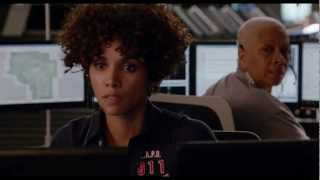 This article is a review of a blockbuster movie. The article makes political comments about a dominant genre in United States productions and about how little choice there is in Australian cinemas these days. Candobetter welcomes debate on the paucity of cinema available in Australia.
This article is a review of a blockbuster movie. The article makes political comments about a dominant genre in United States productions and about how little choice there is in Australian cinemas these days. Candobetter welcomes debate on the paucity of cinema available in Australia.
The call stars Halle Berry, Abigail Breslin, Michael Eklund and was directed by Brad Anderson.
My expectations with this movie were not high, but I did enjoy it, despite its ugly subject, and I thought it was well-done, well acted and innovative - for a blockbuster.
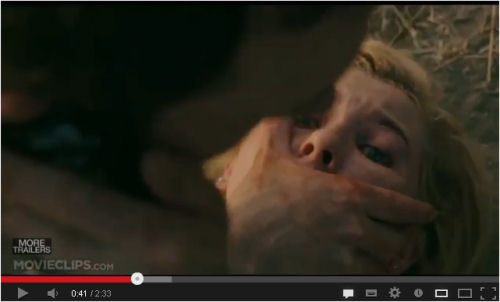
I finished up going to see it because there was nothing on at the local cinema - indeed, all over Australia - except overblown US-sourced blockbusters. Even the so-called art-house cinemas have the same pathetic range lately. However, I wanted a stimulating but not too intellectually taxing night out. The only remotely promising title seemed to be "The Call".
I checked out the reviews and they were universally poor. I watched a trailer and thought the film looked better pitched than your usual schlock. So I went to see it.
I don't agree that it degenerates at the last part (as suggested in another review). The change of role for the 911 attendant is innovative but not illogical. Indeed it is morally logical and makes a good story. I must admit that I like to see women fight back against sexual aggressors and ridicule them. There are far too many schlock films where the women submit pathetically to their fate if no beefy 'hero' turns up to rescue them.
There were logical faults in the earlier attempts to trace the kidnappee in the trunk of a car, but suspending belief was not difficult. I found the exploration of techniques to draw attention to one's plight in a car boot interesting and potentially useful. Unfortunately so will real-life predators.
These kinds of movie also strike me on another level of poltical metaphor. I find it interesting that the United States produces so many movies (many inferior and some superior)like this where citizens are portrayed as beset by wolves among their own flock. All the while the politics of savage capitalism wage war on the ordinary citizens but the mainstream art forms convince citizens to distrust each other. Encouraged to be remote from their larger political processes, Americans have been refocused onto bogeymen, like so many children, and this focus seems to give rise to an unusually large number of real-live-bogeymen, possibly with life imitating the kind of art this movie represents.
I would prefer a much wider range of lateral thinking type mysteries and thrillers than are provided these days to Australian cinemas by almost exclusively US-sourced material. I do get really sick of psychopathic killers and cop plots. There are so many other things in the world that these genres totally ignore and art is much poorer for it.
However I will give this movie a 4.5 out of 5 considering the dross among its competitors. My bloke, who I dragged along with little consultation, also found it reasonably entertaining.
On reflection I would give the recent movie about Abraham Lincoln a 9 out of 10 - so that shows that I apply different measures for different kinds of movie.
I am posting this movie review on candobetter because, when I tried to post it elsewhere, I became sick of having my phone number and address demanded before my post would be accepted. My excuse for posting this bit of lite-review stuff here is that I do make some broader political comments and because I like the way candobetter.net doesn't try to make money out of contributors. And, why did I originally bother to write anything at all about it? Because I thought that critics were unfair to the movie and it cost me little to redress the balance. In the scheme of things, how important is this?
Not very.
Directed by Brad Anderson; written by Richard D’Ovidio, based on a story by Mr. D’Ovidio, Nicole D’Ovidio and Jon Bokenkamp; director of photography, Thomas Yatsko; edited by Avi Youabian; music by John Debney; production design by Franco G. Carbone; costumes by Magali Guidasci; produced by Jeff Graup, Michael J. Luisi, Michael A. Helfant, Robert L. Stein and Bradley Gallo; released by TriStar Pictures and Stage 6 Films. 1 hour 35 minutes
WITH: Halle Berry (Jordan Turner), Abigail Breslin (Casey Welson), Morris Chestnut (Officer Paul Phillips), Michael Eklund (Michael Foster), David Otunga (Officer Jake Devans), Roma Maffia (Maddy), José Zúñiga (Marco) and Michael Imperioli (Alan Denado).

 Dale Peterson begins his thesis with the execution of elephants for crimes of murder against humans. An unusual, well-argued and inspiring book. Peterson co-authored the famous Demonic Males, an anthropological study in their own environment of several kinds of apes, including humans. I expected him to come up with something new on the subject of animal morality, and I was not disappointed. This is a real thesis, a slow burning one that reaches a high temperature.
Dale Peterson begins his thesis with the execution of elephants for crimes of murder against humans. An unusual, well-argued and inspiring book. Peterson co-authored the famous Demonic Males, an anthropological study in their own environment of several kinds of apes, including humans. I expected him to come up with something new on the subject of animal morality, and I was not disappointed. This is a real thesis, a slow burning one that reaches a high temperature.
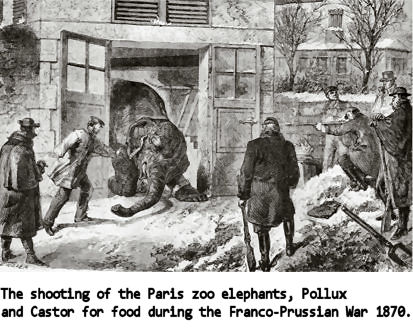
Dale Peterson begins his thesis with the execution of elephants for crimes of murder against humans. He thus arrests our attention with a couple of concepts most of us probably don't mull over every day in relation to elephants: 'execution' and 'murder'.
Firstly, he calls to our minds the difficulty of killing an elephant and of how authorities 'execute' elephants mostly when those animals have done something that makes them seem pretty dangerous - generally maiming or killing a human. The level of decision-making and authority to kill the elephant in question is such that it takes on the character of an execution and a punishment.
Then he introduces the concept of 'murder' by non-humans of humans. He shows how people in earlier times have tended to assume intent and deliberation in animals and that, even though this assumption has been largely dropped with the institution of Cartesian values that say animals are machines without feelings, with elephants people tend, despite themselves, to assume intelligence and planning.
Australians might recognise the motif of execution and murder in the way we sometimes deal with sharks and crocodiles after one of them has killed one of us. And then, there is our attitude to dingos. And pit-bulls.
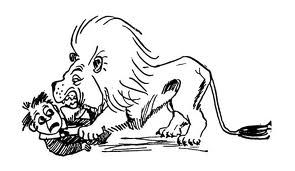
An important part of Peterson's logic depends on establishing that most species think of themselves as the most important, possibly the only 'real' species, just as humans do. He gives an example of how, when human observers were educated not to interact at all with non-human apes in the Goodall studies - the non-human apes simply forgot the human apes were there. They accommodated their presence in the sense that they went around them, but the almost never attempted to interact. Humans went off their radar - just as most other species are nearly always off most humans' radars.
Obviously you have to read the book to understand what Peterson is talking about here. He is sufficiently original to surprise most people saturated in animal ethology, evolution and animal rights literature.
Species self-centredness does not exclude a capacity for empathy when there is meaningful interaction with another species and within one's own. Peterson defines empathy and argues very effectively that this is an evolutionary trait shared by many species apart from humans. Readers may not be surprised by this observation, but they will probably be impressed by the reasoning and examples.
With this significant beginning, Peterson goes on to examine other perspectives on animals in laboratories and in the wild which many of us won't have thought of. He also has a lot of unusual but well documented examples from the wild, in part due to his long association with Jane Goodall.
When I was deliberating about buying this book, I wondered how Peterson would deal with his own emotions on these subjects and with those he might expect in a reader. Emotional attitude is very important in such works because it can put readers off for a number of different reasons. For instance, some readers might seek to avoid the pain of knowing of awful treatment of animals. Conversely, animal rights readers might suspect an author who did not express indignation and anger. On the other hand, scientific readers and people used to repressing their emotions might prefer an absence of emotion. How does Dale Peterson deal with this? He doesn't become 'emotional' but he nonetheless validates the experience of animals by describing their reactions - for instance how laboratory rats would go hungry and even risk starvation to avoid imposing pain on their rat-neighbours when that was a risk entailed in seeking food - for instance where pressing a lever to get a pellet of food appeared to cause another rat to receive some kind of 'punishment'.
Does Peterson rail against the people who would deliberately cause animals - from lab rats to chimpanzees and elephants - pain? No, he doesn't. But the actions of the animals to protect each other dignify the animals themselves, and so the reader makes their judgement.
Peterson succeeds here in a very difficult field: he teaches us that the matter is too serious for mere indignation. Serious in a manner that requires intense reflection on our relationship with other creatures, with ourselves and each other.
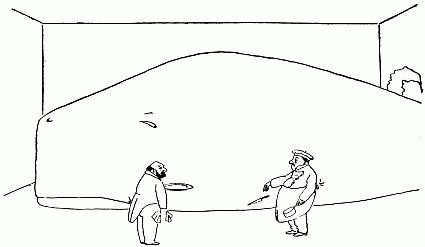
"The puffin (harvested locally, the waitress promised) was sliced thin, its gaminess muted with litchi and fig. The minke whale, also finely carved, tasted like beef tenderloin with a faint metallic finish; it was savoury and delicate when paired with an airy washabi cream." (Liz Alderman, New York Times travel journalist, 2013)
The industrialized killing of whales during the twentieth century was 'perhaps the most callous demonstration history offers of humankind's self-appointed dominion over animals. One searches almost in vain for an expression of sympathy, compassion, understanding, or rationality. In their place were only insensitivity and avarice.' (Richard Ellis,2003. The Empty Ocean).
Whales are present throughout the book, an undercurrent in the form of educated interpretations of Moby Dick, which will absolutely fascinate anyone who has studied it, but the cetaceans surface, so to speak, in their full glory, in the last chapter.
Now I am not one to be impressed by interspecies comparisons with human intelligence because I don't think I judge other species' worth in relation to humans. I have therefore never been very taken by the popular iconology of whales and porpoises. I love the sea and enjoy the creatures in it. They are a whole other planet. They do not need to be like me for me to want them to be.
No, when I think of whales, I think about how, when I was a child about five years old I participated in one of the last whale hunts off the West Australian coast. Two whalers were involved - one Australian and one Russian. My father (a scientist) was a guest for the day on the Russian boat and my mother and I were on the Australian one. The two boats competed for a mother whale and her calf. The Russians caught the mother and the calf. It was windy. The sea was roiling. The whales, although huge, appeared and disappeared among the waves. I remember the excitement of the pursuit and apparently friendly competition between the boat crews pursuing the same whale.
When we came ashore, we left the real crews to deal with their catch and drove to the country pub where we were sleeping.
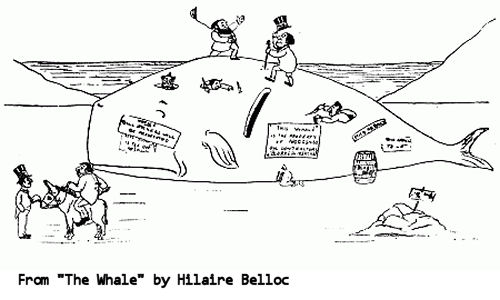
Early the next morning we returned to the whaling station, eager to see the work that had been done. We climbed up on a rise above the station and looked down into a bay like a pit between cliffs. Our stomachs lurched at the sight. Humans were climbing over the partially exposed skeleton of the huge mother whale in a scene that resembled one of Hieronymous Boch's versions of hell. They were hacking away at the giant creature like ants with axes and knives. Was the little one lying beside its mother? I cannot be sure of my memory. I do remember that even my father (a man who made his own spears for underwater fishing) lost his bullish enthusiasm for the scene. The terrible smell of rotting whale even outdid the visual desecration of such an obviously monumental animal. Above everything else, the smell drove us away, gagging with horror, suddenly deeply depressed.
I was glad when I became aware they had banned whaling some years after that. Since then I have enjoyed the sight of whales with the feeling that - at least those I can see in Australia - are not menaced by a local whaling industry. Since there are already so many people out there protesting on behalf of whales, with an apparent appetite for associated posters and films, I have felt I could choose to spend my time trying to defend our very deserving Australian indigenous land-creatures and vegetation, which lack the profile in their own country that whales do, but suffer similarly.
Reading Dale Peterson's last chapter, however, concentrated my mind on the precarious position of whales. Peterson doesn't waste the reader's time with excess adjectives and examples. He makes the matter perfectly clear. Some whale populations that recovered from initial whaling bans are now nearly extinct, largely due to the current activities of the Japanese, the Greenlanders and the Icelanders. Some of the biggest creatures on the earth - with much larger brains than ours and similar neuronal connections - and perhaps with superior morality and values - are close to being wiped out by a bunch of badly-educated apes who no longer are in touch with what is going on around them. There is no excuse for whaling. There is no excuse for extinction. We have no excuse, except perhaps that, collectively, we humans are not as smart as we think.
"Altogether the brains of cetaceans show 'a structural complexity that could support complex information processing, allowing for intelligent, rational behavior.' That's the word from the neuroanatomists, and those scientists who have been studying cetacean behavior for the last several decades strongly support it, finding a group of animals who have excellent memories and high levels of social and self-awareness, who are excellent at mimicking the behavior of others and can respond to symbolic representations, who form complex and creatively adaptive social systems, who show a broad capacity for the cultural transmission of learned behaviors ... and so on."
"Nearly half of the thirteen great whale species are currently listed as endangered, some critically so, while a number of localized populations are gone or just about gone. The right whale of the North Atlantic, once common, is now down to a population of around three hundred and still declining. These giant animals were given their name in the old days because, as slow-moving and naturally-buoyant-after-death creatures, they were the 'right' ones to find and kill. Now they are right for extinction, with their continuing decline today, largely the consequence of accidental collisions with ships. The magnificent blue whales of the Antarctic, abundant until whalers discovered them, have been reduced to around 1 percent of their original numbers. At more than a hundred feet long and 150 tons heavy, incidentally, these animals are the largest creatures ever to have lived on this planet, land or sea, but they, too, are teetering on the edge of nonexistence. Also endangered or threatened are the gray whales of the northwestern Pacific, the fin whales, the sei, the beluga, and the sperm whales. 'Trusting creatures whose size probably precluded a knowledge of fear,' writes author and marine wildlife expert Richard Ellis, in The Empty Ocean (2003), 'the whales were chased until they were exhausted and then stabbed and blown up; their babies were slaughtered; their numbers were halved and halved again.' The industrialized killing of whales during the twentieth century, Ellis concludes, was 'perhaps the most callous demonstration history offers of humankind's self-appointed dominion over animals. One searches almost in vain for an expression of sympathy, compassion, understanding, or rationality. In their place were only insensitivity and avarice.'
"The International Whaling Commission (IWC) was originally organized in 1946 to support the industry by promoting the supposedly 'sustainable' harvesting of whales. But commercial whaling had, by the second half of the century, reduced the numbers of most species so decisively that in July of 1982 the IWC declared a moratorium on all whaling.That important and positive event has been challenged continuously by the Starbucks[1] of this world. The Soviet whaling industry simply continued harvesting whales of all species, all ages and sizes, while falsifying their reports. The Japanese officially adhered to the terms of the moratorium by identifying their whaling as 'scientific' rather than a commercial enterprise. Iceland ignored the moratorium, allowing its ships to kill one hundred minke whales and as many as one hundred and fifty endangered finned whales during the 2008 and 2009 seasons. The Norwegians have never stopped whaling either and continue to slaughter hundreds of minke whales yearly, insisting that whale killing is a glorious part of their cultural heritage and, furthermore, that these giant mammals eat too many fish. During the 2009 meeting of the IWC, meanwhile Greenland,backed by the Danish government, applied for permission to harvest as many as fifty endangered humpback whales over the next five years for the purposes of 'aboriginal subsistence,' even though Greenland already has a surplus of whale meat, which is sold in supermarkets."
After I began writing this review, I was sad to read the following in an internationally syndicated travelogue by New York journalist, Liz Alderman, about Iceland nightlife:
"We studied the menu and pointed to the puffin and minke whale appetisers, Icelandic delicacies. The puffin (harvested locally, the waitress promised) was sliced thin, its gaminess muted with litchi and fig. The minke whale, also finely carved, tasted like beef tenderloin with a faint metallic finish; it was savoury and delicate when paired with an airy washabi cream."
Liz Alderman was not starving, was not an indigenous hunter, was not unable to procure other kinds of food, so how could she be so blind and deaf and dumb to the imminent extinction of the whale and the puffin?[3] And, if it sold articles, would she also sample elephants' tusks and tigers' bones? Where would she draw the line? Would she, could she draw a line anywhere?
Is there any hope for the world? Are we any different from the Ancient Romans who gorged themselves with rare animal dishes and self-induced vomiting so as to be able to eat more?
It is as if every local rule that ever developed to save something for later and maintain the populations of food sources is being eroded by marketing for short-term gain to nations of unhappily fat people who cannot avoid exposure to the brainwashing.
I know I am not the only one who is absolutely sick of the multiplication of cooking shows on television. I rarely turn on my own television, but television is now everywhere - on the back of airline seats, in hospitals and doctors' waiting rooms, in public squares. It is a form of ideological pollution. At every hour of day and night we are sold the idea of eating more and more kinds of animals, to seek the out wherever they may hide and popularise their demise. So we are supposed to admire a man who urges us to taste fried spiders, then follow the camera's eye as it roves greedily over other produce, passing casually over the sad little face of a small dead bat. The image haunts me still, because I have actually been friends with a bat. I recorded it in this film, Gracie, the flying fox.
Julia Buch, who introduced me to the friendly bat took to saving baby bats orphaned on bat hunts in New Guinea, when she was a child. A tradition of bat eating among a small population of New Guinea clans-people is one thing; 7.5 billion people hunting down every bat and every spider, every tasty rare plant and turning their habitats into fields for soy and corn is like some kind of scary nightmare. Yet that is what is happening! Humans have become the nemesis of every other creature in the world. Our behaviour is monstruous.
[1] Starbuck was one of the characters in Moby Dick. He was less impressed by Moby Dick and Captain Ahab than most of the crew. He wanted to get on with business and go home to his wife.
[2] Liz Alderman, "The nights and lights of Reykjavik," Australian Financial Review, February 22-24, 2013, pp22-24.
[3] Puffins are hunted for eggs, feathers and meat. Atlantic Puffin populations drastically declined due to habitat destruction and exploitation during the 19th century and early 20th century. They continue to be hunted in Iceland and the Faroe Islands.
The Atlantic Puffin forms part of the national diet in Iceland, where the species does not have legal protection. Puffins are hunted by a technique called “sky fishing”, which involves catching low-flying birds with a big net. Their meat is commonly featured on hotel menus. The fresh heart of a puffin is eaten raw as a traditional Icelandic delicacy.
Conservation
SOS Puffin is a conservation project based from the Scottish Seabird Centre at North Berwick to save the puffins on islands in the Firth of Forth. Puffin numbers on the island of Craigleith, once one of the largest colonies in Scotland, with 28,000 pairs, have crashed to just a few thousand due to the invasion of Tree Mallow, an exotic plant which has taken over the island and prevented the puffins from accessing their burrows and breeding.[21] The project has the support of over 450 volunteers and progress is being made with puffins returning in numbers to breed this year.
In the summer, children in Iceland walk around local areas with boxes and containers to rescue puffins that land in dangerous spots, such as close to cities, where the city light has confused them into trying to fly into that direction, as opposed to diving in the direction of the light reflecting off the sea water near their burrows. The children who rescue puffins then later release them at sea, and away from the city. Source: Wikipedia http://en.wikipedia.org/wiki/Puffin
Sheila Newman is an evolutionary sociologist. Her home page is http://candobetter.net/SheilaNewman Her most recent book is reviewed at /?q=node/3155. See below for where you can obtain a copy.
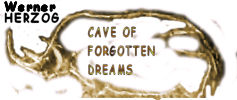

Retitled on 4 November 2011 to highlight the megafauna focus
In 1994 three French speliologists (cave explorers) found the Chauvet Pont d'Arc cave, which turned out to be an extensive underground neolithic art gallery and a kind of visual Noahs Ark of lost species of the last great ice-age around 34,000 year ago. By comparison, the famous cave art of Lascaux[1] is about half as old. Werner Herzog's film of this great ecological time machine is a once-ever.
Soon after it was found, the government resealed the Chauvet cave with a massive armored door so that, from the outside, it looks like the entrance to a bank vault mysteriously set within a wall of rock, overlooking vinyards in Ardeche. In a kind of electronic open-Sesame, entry is gained via a code typed on a keypad.
The French Ministry of Culture gave veteran film-director, Werner Herzog,[2] special permission to enter the cave and make the documentary. His permitted time was limited to hours at a time over a few days, I believe, and he was only allowed to bring in three other people. The crew was might only use battery powered flat lights and they had to keep to a narrow raised pathway. Internauts can follow the same path in a virtual interactive page. (If you don't understand French just be aware that hovering your cursor or clicking on a highlighted square will bring up further detail.)
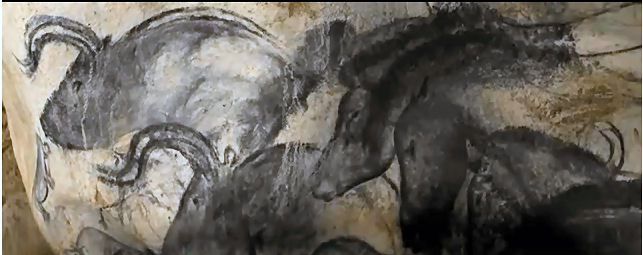
Herzog has made a wonderful film about what humans living over a period of thousands of years in the time of a great ice-age left behind them. The art and informed scientific commentary give an empathic audience the material to bridge with their imaginations a gap of more than 34,000 years and to walk between towering glaciers with ancestors who hunted megafauna. The film brings to life (in 3D) a time when seas were 300 feet lower (91.44 meters) and people and other animals could walk from Germany to Britain. I have always valued the idea of the space and freedom and self-sufficiency of the neolithic and would have liked to have lived at that time. The cave paintings were superbly lively and evoked an era when humans identified as part of the local ecology which included huge cave bears, cave lions, wooly mammoths and wooly rhinoceroses in Europe, all of which are depicted in the cave.
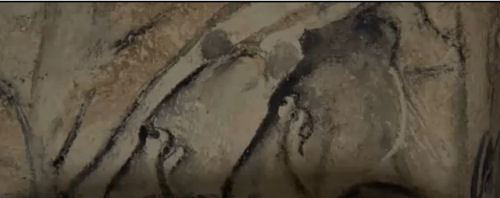
In the film, scientific specialists interpret the paintings and the times. One of them went into the weaponry used for hunting, demonstrating the importance of spear throwers. These neolithic people were tall and amazingly fit and strong to be able to live in the extreme cold and to hunt and live among the huge creatures of the time. The paintings depict the non-humans as real personalities. An approach through naturalistic art, which everyone can understand, makes this a meaningful diorama of neolithic culture.
None of the many bones on the floor were human. It is thought that this cave was lived in by various animals over centuries and that humans used it for ceremonies, but no-one is sure, of course. There is a wolf paw-print besides an eight year old boy's footprint in the earth in one of the cave areas, but the two could have walked here 5000 years apart or side by side on the same day. No-one can say.
It saddens me that if Australia continues to "develop" the territory and society of her aboriginal peoples, inevitably no Australian will any longer have a choice of that other lifestyle, which still carries valuable information about a wonderfully healthy way of relating to nature and to each other. Changing their remaining land from shared territory to individual titles, as begun by John Howard, will effectively break up these peoples too, reducing them simply to a part of the flotsam of broken tribe remnants arriving as 'settlers since 1788 - the poor from industrial Britain, the Continent, Asia and Africa. Europeans may understand the tragedy of reducing everything to industrial life-style even less than Australians. I remember giving a lecture to contemporary French history students at the University of Dijon where students expressed shock that Australian aborigines wore no clothes in indigenous territory in the north of Australia. For them this was a sign of poverty. Living 'outdoors' was a sign of 'backwardness'. Would those same students have felt the same way seeing Herzog's film of Chauvet Pont d'Arc?
The Australian Aborigines are thought to have crossed over when sea-levels were very low between 60 and 40,000 years ago, more or less direct from Africa. The oldest neolithic art in Cave of Forgotten Dreams was dated round 34,000 year ago. Until British settlement in Australia the populations there were all still practising neolithic lifestyles and showed no immediate interest in beads and baubles; they seemed to have too much self-respect and to be self-sufficient without notions of individual wealth. This culture is still alive, hanging by a sinew. It depends on the retention of land and a social envelope that does not impose growth in population and material production ...
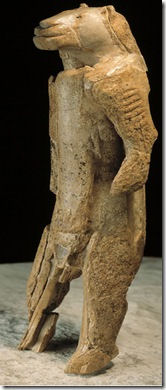 Also fascinating in Herzog's film was the introduction of the concept of 'fluidity' between humans and other animals which some of the cave painting and other neolithic art seems to demonstrate, where it was supposed that humans believed that combinations could easily occur between themselves and other species. So there exist figurines of lion-headed humans etc. Of course the ancient Egyptians had a panoply of animal-headed gods and Greek myth contains half-human monsters. Statuettes like the Venus of Willendorf seems to have been very common items in the Neolithic. What was the basis of these statuettes, I wonder? Fertility figures? They look like old women with diabetes to me, or, disturbingly, obese women held captive and fattened for some awful purpose. "How," asked a female friend, "Could women of the neolithic period get that fat?" Was there enough cereal? Did they survive winter on huge amounts of fat sitting immobile in caves? The mind boggles...
Also fascinating in Herzog's film was the introduction of the concept of 'fluidity' between humans and other animals which some of the cave painting and other neolithic art seems to demonstrate, where it was supposed that humans believed that combinations could easily occur between themselves and other species. So there exist figurines of lion-headed humans etc. Of course the ancient Egyptians had a panoply of animal-headed gods and Greek myth contains half-human monsters. Statuettes like the Venus of Willendorf seems to have been very common items in the Neolithic. What was the basis of these statuettes, I wonder? Fertility figures? They look like old women with diabetes to me, or, disturbingly, obese women held captive and fattened for some awful purpose. "How," asked a female friend, "Could women of the neolithic period get that fat?" Was there enough cereal? Did they survive winter on huge amounts of fat sitting immobile in caves? The mind boggles...
In the meantime, my mind retains those wonderful pictures of megafauna and of a time more fabulous than that of any comic superhero.
[1] For the cave art of Lascaux, visit this wonderful interactive site where you can move around within the caves at a touch of your mouse
[2]Werner Herzog as a director was better known to me as the German maker of Nosferatu (1979), a poetically filmed interpretation of the lonely vampire myth and the plague in Europe.
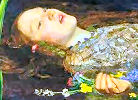 It is surprising to pick up a book about wealth statistics and find that it segues so readily into another about psychopathology in young girls. The Spirit Level: Why Equality is Better for Everyone takes a revealing look at how wealth is distributed within different developed countries and Reviving Ophelia illustrates the decline of women's rights in the face of aggressive pornography and its effect on girls. Children and the general public were not widely exposed to explicit pornography and sexual sadism in the ‘traditional’ mass media of the industrial age, although these notions were commonly implicit in images and concepts used for marketing all kinds of things. Between that time and now, in 2011, the depiction of women almost exclusively as victims and objects of violence and pornography, explicitly and for that sole reason, has become a global business which operates 24/7. The implicit violence and sexualisation of women in ordinary marketing has also continued. At the same time, the official message is that western women don’t need Feminism anymore because equality has prevailed.
It is surprising to pick up a book about wealth statistics and find that it segues so readily into another about psychopathology in young girls. The Spirit Level: Why Equality is Better for Everyone takes a revealing look at how wealth is distributed within different developed countries and Reviving Ophelia illustrates the decline of women's rights in the face of aggressive pornography and its effect on girls. Children and the general public were not widely exposed to explicit pornography and sexual sadism in the ‘traditional’ mass media of the industrial age, although these notions were commonly implicit in images and concepts used for marketing all kinds of things. Between that time and now, in 2011, the depiction of women almost exclusively as victims and objects of violence and pornography, explicitly and for that sole reason, has become a global business which operates 24/7. The implicit violence and sexualisation of women in ordinary marketing has also continued. At the same time, the official message is that western women don’t need Feminism anymore because equality has prevailed.

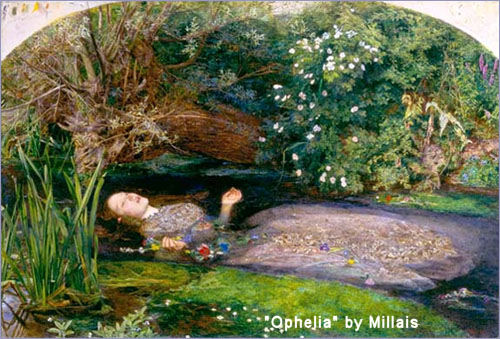
In the Australian Financial Review, September 13, 2011, Deidre Macken writes, “After a week when economic statistics made a lie of our feelings of being worse off, it seems like an opportunistic time to check how good we are at reading ourselves. Obviously we are not good judges at assessing our economic well-being. Repeat after me – we are a lucky people, living in a country that’s never been luckier.”[1]
Without going into the adequacy of the indicators she used but does not reference, was Deidre talking about averaged statistics or was she talking about the way they are distributed throughout the nation?
I chose a quote from a female financial journalist to introduce the feminist implications of the theories of two books. One was published nearly two decades ago and the other was published last year. The earlier one is by Mary Pipher, with the title of Reviving Ophelia: Saving the selves of adolescent girls. It was published by Riverhead Books, New York, 1994. The second book is by Richard Wilkinson and Kate Pickett. It’s title is The Spirit Level: Why Equality is Better for Everyone, and it was published by Penguin in 2010.
Both books are about the impacts of inequality as you and I experience it, rather than the global economics of inequality between different countries by which the first and the third world are often defined. I found these books interesting particularly in the light of the recent inquiry into human rights in Australia, which ignored Australian citizens’ rights by concentrating on international rights. Citizens’ rights require active democracy and laws to facilitate this, whereas global human rights are relative abstractions, requiring recognition by national governments in hard-to-enforce treaties.
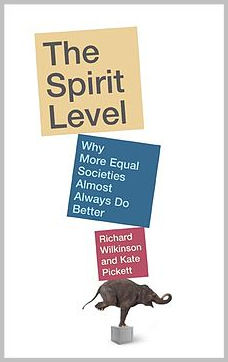
Richard Wilkinson and Kate Pickett in The Spirit Level: Why Equality is Better for Everyone, Penguin 2010 beg the question of defining countries as rich or poor according to their average wealth. The book points out that, although Australia or the United States might have relatively large GDPs for their total populations, large sections of those societies are politically, materially, socially and physically disempowered and disadvantaged by their relative poverty. The authors imply that these differences drive seriously negative outcomes in almost any area you care to think of. The more unequal you are with the people geographically close to you – in your neighbourhood, your state, your nation - the more anxious and dysfunctional you are likely to be. Inequality is actually an indicator of relative unhappiness and that unhappiness is linked to many social and physical ills, including violence and obesity.
Further on we will relate the lesser condition of women as a subclass within these unequal nations.
Wilkinson and Pickett suggest that, rather than comparing “rich countries with poor countries” we should compare rich countries and then look inside them to see how well they are actually looking after their people.
Within countries like Japan and some of the Scandinavian countries … the richest 20 per cent of people are less than four times as rich as the poorest 20 per cent of people. At the bottom of the [scale] are countries in which these differences are at least twice as big, including two in which the richest 20 per cent get about nine times as much as the poorest. Among the most unequal are Singapore, USA, Portugal, the United Kingdom, Australia and New Zealand. (p.16-17)
The book makes no attempt to explain why Portugal should stand out in such a contrast to its continental European neighbours, which almost invariably outperform English speaking countries on equality and social conditions. I would suggest however that one reason lies in Portugal's inheritance laws, which reflect a tendency to disinherit children in favour of spouses, similar to English-style laws. In the other European countries roman-style civil codes provide for children before spouses equally, therefore men and woman come to adulthood with similar wealth.
Wilkinson and Pickett find that the countries with the worst social inequality have the worst social outcomes overall in health, violence, obesity, illiteracy, mental illness, addiction, and rates of teenage pregnancy.
The official message is that developed western countries have done their duty by their own populations in fulfilling their material needs, leaving a remaining task of bringing the poor of other countries up to the same material standard. It seems churlish of people in those first world populations to reproach the rich in their countries for ostentatious and dishonest living, while the poor in the third world suffer malnutrition and disease. The official message is really that the poor of the developed world need to put the needs of the poor of the undeveloped world ahead of theirs, rather than to exert their own rights locally. The normalization of competitiveness over cooperation and social trust is a strategy to justify the growing vast internal inequalities in the first world.
Importantly for Feminism, within these unequal nations there is a further sub-class, and that is the women of those nations.
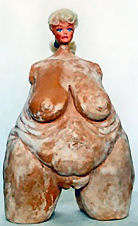
Most women would be interested to know that the authors, Wilkinson and Pickett, are able to find a clear association between inequality, obesity and the female sex.
The World Health Organisation has found, from a study begun in the 1980s, that in the 26 countries it surveyed, rates of obesity have increased more among poor women than rich women. The countries with the worst inequalities – Australia, the United States, Portugal and the UK, also have the worst rates of obesity. The countries with the lowest rates of inequality have the lowest rates of obesity.(p.98)
Observing a relationship between anxiety and material and social inequality, the authors note that chronic stress stimulates the hormone, cortisol, of which high levels are associated with deposits of fat around the middle.(p.95) People with this kind of fat are at higher risk of other illnesses – notably diabetes. Diabetes is itself associated with depression.
The authors also refer to the concept of the ‘thrifty phenotype’ where birth weights are lower in women who have experienced stress during pregnancy. Are low-birth weight babies likely to squirrel away extra calories because the stress they encountered in utero led them to prepare for a harsh society, where they would expect to struggle for food? Instead, although they do grow up in a harsh society, it is a non-traditional variety where food remains plentiful but love and approval are at a premium. (p.98)
The book also notes that food may stimulate the brain in the same way as addictive drugs do in people who use food addictively. That is, that food may be used as a pain-killer. (p.96)
It is probably obvious that food marketing may also have a role in obesity, but what is that role? The authors find associations between eating for comfort and homely foods which remind people of childhood, but they note that fast food outlets aim to reassure and to provide the lower classes with a feeling of social mobility. They reassure through their reliability and clean surroundings, but they also provide an affordable opportunity to dine out, which was once the province of the rich. Of course when you dine out on fast food, you are taking in huge amounts of calories in the form of fats and sugars, to a degree not found in haute cuisine restaurants.(p.96)
The book also refers to a study which related obesity to people’s subjective sense of ranking low in the social pecking order. That is, how you feel you compare is more important than your absolute living standard.(p.101)
To recapitulate, this book is about how, once the basics are present, absolute living standard is outweighed by social ranking as measured by relative living standard.
Importantly for Feminism, within these unequal nations there is a further sub-class, and that is the women of those nations.
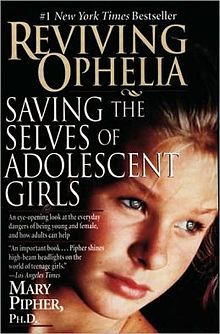
In Mary Pipher’s Reviving Ophelia: Saving the selves of adolescent girls, (Riverhead Books, New York, 1994) the subject is also about inequality and anxiety within high GDP, purportedly progressive societies. Despite the rhetoric, she argues, girls receive a consistent message that they don’t deserve equal treatment and must go to outlandish lengths for mere acceptance. For this reason the whole basis of their identities become at risk as they identify as women rather than as children. They learn that their psychological identities depend on the approval of men. This explains the very high rates of anorexia and risky lifestyles among young women seeking some control over their social and personal environments.
Harking back to Shakespeare’s Ophelia in Hamlet as a young woman who lost the approval of the important males in her life and then suicided, this book observes the increasing difficulty since the 1980s that adolescent girls and the women they become have in preserving a sense of self and self-worth as they transition between childhood and maturity. It finds that they are victims of an increasingly sexualized and pornographic society that defines them almost exclusively as sexual objects, despite the official rhetoric of women’s rights. The girls feel the need to justify themselves against these media popularized and reinforced social standards and, in doing so, to suppress their real feelings and ambitions.
The author observes that, whilst her 1960s generation grew into a western society where the Women’s Liberation movement had overturned official institutional barriers to women’s rights to career, property and political candidacy, the mainstream media preserved, then enhanced over the next decades, a picture of women as inherently less-deserving of these rights than men. Unglamorous, older women (the majority) rarely receive attention in the mass media, and beautiful women often seem only to deserve violent attention, as victims of elaborate predator screenplays. Women are increasingly bombarded by this kind of view at younger and younger ages.
This book, Reviving Ophelia, was published in 1994, at a time when the pervasiveness of the internet was in its relative infancy. Children and the general public were not widely exposed to explicit pornography and sexual sadism in the ‘traditional’ mass media of the industrial age, although these notions were commonly implicit in images and concepts used for marketing all kinds of things. Between that time and now, in 2011, the depiction of women almost exclusively as victims and objects of violence and pornography, explicitly and for that sole reason, has become a global business which operates 24/7. The implicit violence and sexualisation of women in ordinary marketing has also continued. At the same time, the official message is that western women don’t need Feminism anymore because equality has prevailed.
How does a girl, as her sexual personality awakens deal with the saturation marketing of femaleness as moronic and deserving of punishment and death? Mary Pipher argues that girl’s personalities die and that they often die with their personalities.
”Ironically, bright and sensitive girls are most at risk for problems. They are likely to understand the implications of the media around them and be alarmed. They have the mental equipment to pick up our cultural ambivalence about women, and yet they don’t have the cognitive, emotional and social skills to handle this information. They are paralyzed by complicated and contradictory data that they cannot interpret. They struggle to resolve the unresolvable and to make sense of the absurd. It’s this attempt to make sense of the whole of adolescent experience that overwhelms bright girls.
Less perceptive girls may miss the meaning of sexist ads, music and shows entirely. They tend to deny and oversimplify problems. They don’t attempt to integrate aspects of their experience or to ‘connect the dots’ between cultural events and their own lives. Rather than process their experience, they seal in confusion.
Often bright girls look more vulnerable than their peers who have picked up less or who have chosen to deal with all the complexity by blocking it out. Later, bright girls may be more interesting, adaptive and authentic, but in early adolescence they just look shelled.
Girls have four general ways in which they can react to the cultural pressures to abandon the self. They can conform, withdraw, be depressed, or get angry. Whether girls feel depression or anger is a matter of attribution – those who blame themselves feel depressed, while those who blame others feel angry. Generally they blame their parents. Of course, most girls react with some combination of the four general ways.” (p. 43.)
Girls deal with painful thoughts, discrepant information and cognitive confusion in ways that are true or false to the self. The temptation is to shut down, to oversimplify, to avoid the hard work of examining and integrating experiences. Girls who operate from a false self often reduce the world to a more manageable place by distorting reality. Some girls join cults in which others do all their thinking for them. Some girls become anorexic and reduce all the complexity in life to just one issue – weight.” (p.61)
Mary Pipher observes that the loss of confidence in themselves that girls experience as they mature sexually occurs just at the time when more confidence is required to tackle increasingly complex work in the later years of school. Because of this socially-induced lack of confidence, even some highly intelligent girls will give up at the first sign of difficulty, where less bright male students will persist.
The book contains many succinct case histories and concludes with useful ways to approach these problems.
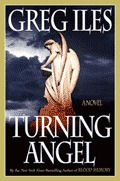
How do men deal with these realities that affect their daughters, mothers and intimates so badly? In conclusion, I will mention a book by a man exploring these themes. spirit-level.jpg by novelist, Greg Iles, (Hodder and Stoughton, 2006) is a highly readable thriller that dramatises the stresses of the normalization of sexism and pornography on young girls [and men] in their last years of high school and the particular vulnerability of highly intelligent young women from dysfunctional homes. Iles looks at the temptation for upwardly mobile professional men to exploit such young women. It is also well worth a read and testifies to the continuing usefulness of the novel as a medium for social comment as well as entertainment.
[1] Deidre Macken, “I’m starting with the man in the mirror,” Australian Financial Review, September 13, 2011.
 An unusual thing about Dick Smith's book, "Population Crisis," is that it is written by a wealthy man who points out the failings of rich people. He says that most rich people give nothing away and describes them as very selfish. "Our economic system comes equipped with only one forward gear: foot to the floor growth. The poor want to be rich, and the rich want to be richer. It's an endless treadmill, and none of our leaders appears to know how to get off." Also inside article: Win $1m if you are under 30 by solving the population puzzle.
An unusual thing about Dick Smith's book, "Population Crisis," is that it is written by a wealthy man who points out the failings of rich people. He says that most rich people give nothing away and describes them as very selfish. "Our economic system comes equipped with only one forward gear: foot to the floor growth. The poor want to be rich, and the rich want to be richer. It's an endless treadmill, and none of our leaders appears to know how to get off." Also inside article: Win $1m if you are under 30 by solving the population puzzle.
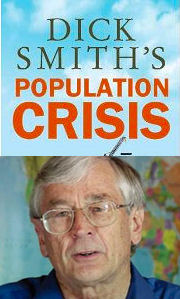 Dick Smith's book, Population Crisis reminds me of the proverb that "It is easier for a camel to go through the eye of a needle than for a rich man to enter the kingdom of heaven," except that here we are talking about the kingdom of Earth.
Dick Smith's book, Population Crisis reminds me of the proverb that "It is easier for a camel to go through the eye of a needle than for a rich man to enter the kingdom of heaven," except that here we are talking about the kingdom of Earth.
The fascinating thing is that the camel may just fit through the eye of that needle in Smith's remarkable attempt to save the earth despite his millionaire wealth.
Books like Tolkien's Lord of the Rings are full of rich and powerful noble creatures standing up for truth and justice and the good of the earth in political systems that rely on the kindness and enlightenment of the powerful and their concern for lesser beings, like hobbits. The reality, however, is quite different, particularly in our global capitalist world, where rich people own or invest in corporations which perpetrate global injustices and manipulate public opinion against democracy and against our own nurturing planet.
Smith looks into the future and sees a looming darkness which no good citizen can ignore, but he recognises that the fight against the vested interests of the growth lobby will not be easy.
"I'm not so idealistic as to believe the necessary changes will come quickly, or that the arguments over climate change will end soon. It seems to me that we are like the generation that existed in the late 1930s in Great Britain. Some predicted that there would be a catastrophe if Hitler was allowed to keep breaking treaties. Others - particularly the business community - said that it was unlikely anything would eventuate and that 'business as usual' was the way to go. That error alone resulted in more than 60 million people being killed. If we make a similar error now, the lives lost and related trauma could be far higher."
Australians with ecological bones and a sense of danger can only hope that Dick Smith's intervention on the subject of population numbers, democracy and ecological impact in Australia will survive the deadening blanket of growthist propaganda, even though Dick Smith himself has predicted that the Murdoch press will destroy him for coming out against population growth in Australia.
His unexpected success with other hard problems caused by powerful forces, offers some hope, however.
Smith's ability to remain an independent thinker and so surprise, straddle and surmount the political wedges created by the mainstream media and the political parties between terrorism, refugee rights and population numbers, makes him stand out in stature above high profile groups and individuals on both sides. It makes his ability and leadership so much more powerful.
When amorphous notions of terrorism and Afghanistan stigmatised David Hicks as untouchable for many, discarding prisoners of war conventions, Dick Smith funded Hicks's civilian defense in Guantánamo Bay - not, Smith precises, because he actually agreed with Hicks's politics, but so that Hicks could get a fair trial.
Smith also became involved in helping to extract hostages in Somalia and with refugee-asylum seeker Peter Qasim. Qasim was detained for nearly seven years by the Australian department of immigration due in part to inconsistencies in his story which others have explained as caused by his dispensing with an interpreter in the mistaken belief that his English was adequate for him to conduct his own defense. The main reason that he was kept imprisoned, rather than deported, was that he was stateless - and therefore had nowhere to go. After Dick Smith's intervention and with pressure from a small group of parliamentarians, Immigration Minister Amanda Vanstone invited Peter to apply for a new class of bridging visa that would allow him to live in the community while his situation was resolved. On 16 July 2005, the visa was granted.
Now Smith has written a book about population numbers in Australia. Smith makes an effort to get on top of this wide and difficult subject in a readable book that addresses the growing and reasonable concerns of both the poor and the aspirational classes of Australia and asks those who benefit from their growing insecurity to reconsider.
"Our economic system comes equipped with only one forward gear: foot to the floor growth. The poor want to be rich, and the rich want to be richer. It's an endless treadmill, and none of our leaders appears to know how to get off."
Smith wants Australians to realise how they cannot rely on the mainstream press to inform them on population politics and gives the example of the Murdoch Press.
He says that he knows politicians are afraid of being attacked by the Murdoch media, but that should not stop them from speaking out against population growth. Despite his own (probably well-founded) belief that the Murdoch media will retaliate and destroy him for criticising growth, Smith actually took out a full page advertisement in the Australian telling Australians of the Murdoch media's investment in population growth.
It is indeed a major irony of Australia's predicament that it has a system that forces all major communications through a biased commercial press which inevitably drowns out any single original initiative with its own ubiquitous and repetitious propaganda.
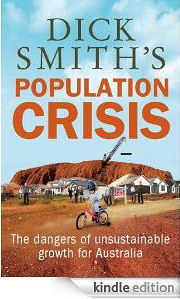
Dick Smith also downplays his intelligence and qualifications. On Margaret Throsby's show on the ABC on 21 June 2011, he said that his only formal qualification was the Baden Powell Scout award.
Smith's intelligence is however uncontestably demonstrated by the fact that at age 38 he had the good sense, self-confidence and self-control to sell the business that made him a millionaire so that he could enjoy his life. That's a bit like Golem (continuing the Tolkein metaphor) ditching the magic ring before it saps his strength.
He writes:
"I was a relatively young man when I sold my Dick Smith Electronics business. When I could no longer see all the weekly figures in one quick look, I felt it was growing too large. [...] For me it seemed the right time to sell the business to Woolworths. They have built it into a billion-dollar business, and many people have told me I was crazy to sell such a growing concern, but I haven't regretted it for a moment. It was the best thing I ever did, because it allowed me to have the freedom to do worthwhile things - to go adventuring, fly around the world and enjoy my life. "(p.129)
That's the kind of intelligence that can see through growthism. It seems that it is rare in the rich.
He goes on:
"I have successful friends, some of them billionaires, and they often say to me that they wish they could do what I did and get out before the business takes over their lives. I tell them they can, but they just shake their heads as if to say, 'Dick, you don't understand. There are all these pressures that make it impossible to just walk away.' Like most of us, rich or poor, they are trapped inside the delusion that we must forever keep growing."
Maybe the Baden Powell Scout award deserves to be taken more seriously. Smith described to Margaret Throsby how being a cub, then a scout, then a rover was formative. The scout movement allowed him "to be an individual, to organise himself, and get into risk taking."
Smith's parents went through bad luck and poverty. At one stage, Smith's father took to his bed for 12 months causing his mother to go out and get a job for the very first time in her life, in a hat factory. Somehow Smith has missed out on that common rich man's delusion that he deserves to be rich because he is special. He sees himself as having drawn good results in life's lottery, but he has demonstrably retained a feeling of solidarity with ordinary Australians.
An example of this fellow-feeling is Smith's Wilberforce Award. 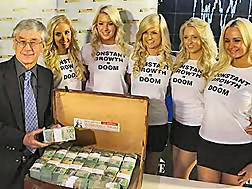
The Wilberforce award is designed to give a one million dollar prize to anyone under 30 who can impress Dick by becoming famous through his or her ability to show leadership in communicating an alternative to our population and consumption growth-obsessed economy.
I can think of one other thing I would have included in the book, had I been Dick Smith. I would have given a detailed account of how, for some very rich people with control over assets, population growth improves the chances of making money. As Smith implies, what makes the rich richer past what he refers to as the "sweet point" tends to make ordinary people poorer. (The "sweet point" is where the cost of growth is less than the gains to be made from it.) I would have liked to have read more detail on how population growth helped Smith make his fortune. It is important to educate Australians on the how and why of this, so that they can see where the corporate growth spruikers are coming from and what they may have to gain from population growth. It would also educate Australians about how difficult having a few people and corporations controlling most of the assets and means of production in this country and elsewhere makes it for everyone else.
One senses that Smith tried to keep things simple in this book. Perhaps he could write another book, to follow up, giving some details on how growth economics and population growth work in favour of the rich and against the rest?
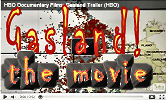 France is about to debate a law to totally ban fracking for gas. Australia has allowed the practice with problems quickly developing. Mexico has no defenses. The United States is deeply affected. "Fracking" was developed by Halliburton, the second largest oilfield services corporation in the world. The term comes from the extraction method of hydraulic fracturing of shale beds to access "unconventional gas" i.e. gas that comes out of wells other than classic oil-wells. Under President Bush, the fracking industry was exempted from environmental laws, including clean water protection. As many of us have come to understand, when you take away environmental protection, you take away almost all human rights to object to big business, even if citizens lives are obviously threatened. We also mention the Australian film made by Four Corners investigating the impacts of the industry in Australia.
France is about to debate a law to totally ban fracking for gas. Australia has allowed the practice with problems quickly developing. Mexico has no defenses. The United States is deeply affected. "Fracking" was developed by Halliburton, the second largest oilfield services corporation in the world. The term comes from the extraction method of hydraulic fracturing of shale beds to access "unconventional gas" i.e. gas that comes out of wells other than classic oil-wells. Under President Bush, the fracking industry was exempted from environmental laws, including clean water protection. As many of us have come to understand, when you take away environmental protection, you take away almost all human rights to object to big business, even if citizens lives are obviously threatened. We also mention the Australian film made by Four Corners investigating the impacts of the industry in Australia. 
France is about to debate a law to totally ban fracking for gas. Australia has allowed the practice with problems quickly developing. Mexico has no defenses. The United States is deeply affected. "Fracking" was developed by Halliburton, the second largest oilfield services corporation in the world. The term comes from the extraction method of hydraulic fracturing of shale beds to access "unconventional gas" i.e. gas that comes out of wells other than classic oil-wells. Under President Bush, the fracking industry was exempted from environmental laws, including clean water protection. As many of us have come to understand, when you take away environmental protection, you take away almost all human rights to object to big business, even if citizens lives and livelihoods, notably through their clean water supply, are obviously threatened. We also mention the Australian film made by Four Corners investigating the impacts of the industry in Australia.

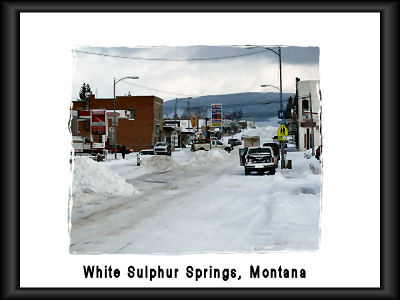
Years ago I spent a couple of months travelling between Colorado and White Sulphur Springs, Montana, in the US with a friend in the petroleum business, who looking into purchasing mineral rights on behalf of some organisations. It was the middle of winter and a blizzard accompanied us the whole way. Our vehicle, an old Lincoln Continental, developed defective wiring so the heaters and de-misters didn't work and the windows wouldn't wind down. As we left Cheyanne, Wyoming, we were wearing ski outfits and using an icescraper on the inside of the windows, wondering just how long we could survive this. When we got to the town of White Sulphur Springs, the main street looked like a bob-sleigh course. The town lacked the money to clear the ice and the only warm place, as I recollect, was under the motel, in a glaucous grotto whence issued the sulphurous springs which apparently gave the town its name.
From this picture I found on the internet, I see that it hasn't changed all that much, except that they are now fracking for gas in Montana.
Why should I mention this?
Well, perhaps to give you an idea of how cold it gets in North America in winter, and just what film-activists like Josh Fox are up against from the general public as well as those who live in warm climates and own shares in gas exploration. Further down we mention the Australian investigation of this industry on Four Corners: See "The Gas Rush," 21 February 2011.
Candobetter.net is a website for reform in democracy, environment, population, land use planning and energy policy. These topics go together naturally, but few single productions bring them together as effectively as Gaslands, a movie made and lived by Josh Fox (no relation to Fox-news, of course!)
Watch this movie and, if you still believe in benign government and that capitalism is the same thing as democracy, please write up your case to amaze us here.
It is really hard to do a review of Gaslands, because even if it were a terrible production, the material raises it to magnificent and frightening heights. The maker of this movie, Josh Fox, was offered a paltry $100,000 for the woods and fields he has lived in all his life, in exchange for mineral exploration rights.
He loved his landscape, which he had grown up with, and he had heard some rumours that fracking sometimes went wrong and cracked water table rock layers, releasing into the water, as well as natural gas and other petroleum by-products, some heavy-duty chemicals used to make water more slippery.
Here is an mp3 about Fracking Fracking: Implications for Human and Environmental Health, Nov 9, 2010 More information here.
Energy in Depth, "Debunking Gasland," is an industry group site containing a response to the movie, Gaslands.
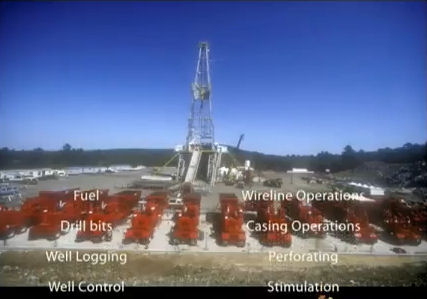 Click here to see a movie which the industry has made in response to the film. The pro-fracking campaign is just as fear-driven as the anti-gas fracking campaign.
Click here to see a movie which the industry has made in response to the film. The pro-fracking campaign is just as fear-driven as the anti-gas fracking campaign.
Unfortunately the industry insists, oilily, that if we want our lifestyles to continue, we have to find more and more fuel to allow our economies to continue to grow. "The world's dependency on oil and gas is a given. Without these fuels, life as we know it, would grind to a stop. " They show a snowbound house with cheery lighted windows, a masked medical team at a patient's bed, a plane taking off, and traffic-laden highways. There is no acknowledgement of the benefits of simplicity, the wholesomeness of nature, the disbenefits of consumerism and growth, or the impact on democracy of capitalism gone mad. This film, however, has a nice animated model of how to drill a well and what fracking entails. The model idealises and simplifies the situation, but it educates on the engineering.
The page associated with this movie is called "Debunking Gasland" and comes from a chapter entitled, "The Energy you need, the Facts you demand." Under, "Who we are," you can read that,
America’s natural gas and oil producers – the majority of which are small, independent businesses with less than 12 employees- are committed to strengthening America through the safe, responsible and environmentally-friendly development of domestic energy resources. Together, we’re working to keep energy affordable here at home, creating new jobs and minimizing our dangerous dependence on foreign oil.
Thanks to new innovations and the hard work of the hundreds of thousands of Americans in the petroleum industry, we’re doing just that. Spread throughout small towns and communities across the country, our companies keep local economies moving by providing goods and generating tax revenues through lease payments and production royalties"
Petroleum depletion trends have galvanised governments and industry to find new reservoir sources of fuel in order to maintain our crazy growth economies. This has placed pressure on environmental standards and laws. Under President Bush environmental protection was apparently shunted aside in order to allow brutal technologies to be used to get coal from sites previously abandoned as too difficult or unrewarding or damaging to the environment, and oil from arctic wilderness. These are desperate and predictable measures. Tarsands - once ignored due to their extremely low return on energy invested and the very high pollution involved - are also now being massively exploited in Canada. As we know deep-sea drilling for oil, with all its risks, resulted in - among other tragedies - the Deepwater Horizon oil-well blow-out of 2010 in the gulf of Mexico.
Fracking gets natural gas from shale formations at very deep underground levels. People are very worried that, whilst shattering these shale formations, underground water tables will also be shattered, ground around the wells will be polluted, and wide open landscapes will take on the appearance of outdoor factories. The industry insists that the shale formations are much lower than the water tables humans access, but there have been several cases where water tables have been proven to have been contaminated. The fracking industry uses huge amounts of fluid - usually water, which is then largely lost to the water cycle. The water is also 'slicked' using various chemicals, many of which are poisonous. (The industry explanation cited above says that many of these chemicals are used in household products, which is true, but these are not generally poured down drinking wells in large quantities.) The slicked water is forced at huge pressures down vertical pipes and then via pipes which penetrate laterally. The aim is to crack and break up the shale formations enough to release gas in large quantities from its multi-chambered underground stores. In Gaslands it has been suggested that, if completely developed, the huge Marcellus shale formation in the United states, under the current very poorly regulated, chaotically individual and uncoordinated system of drilling, could permit as many as 400,000 new wells. This might endanger the supply of water to New York, which would be catastrophic.
It is of concern that similar projects are proceeding in Australia and ABC Australia's 4Corners recently did a very good documentary on this problem. See "The Gas Rush," 21 February 2011. (Video still available on line.) Shown in this documentary was a case of serious contamination of the underground artesian basin, which is Australia's most massive and ancient naturally stored water-source and the main source of water to many inland farmers in the Eastern states.
Fracking is going to be a problem for any country with shale-oil as long as big transnationals make rules for the rest of us. One such country is Mexico, and here is an interesting article, "Fracking in the Four Corners."
Clause 1:
In applying the precautionary principle elaborated in Clause 5 of the Environmental Charter, exploration and exploitation of unconventional hydrocarbon liquids or gases, using vertical and horizontal drills, followed by hydraulic fracturing of rock, is forbidden on National [French] territory.
Article 1er
En application du principe de précaution prévu à l’article 5 de la Charte de l’environnement, l’exploration et l’exploitation des mines d’hydrocarbures liquides ou gazeux non conventionnels, par des forages verticaux comme par des forages horizontaux suivis de fracturation hydraulique de la roche, sont interdites sur le territoire national.
Clause 2:
Exclusive exploration licences to mine unconventional hydrocarbon liquids or gases are now revoked.
Article 2
Les permis exclusifs de recherches de mines d’hydrocarbures liquides ou gazeux non conventionnels sont abrogés.
One of the French ministers involved in drafting this law originally permitted early exploration for fracking. He says that he failed to adequately research the practice and its consequences at the time and is now keen to rectify his mistake.
When I first looked into this matter, I thought that it would take me some time to understand the technology involved and the truth of the complaints against it. But what was not hard to see was that the industry could not proceed as it does if there were any democratic regulation in the interests of citizens. The rate and amount of fracking going on in the United States, and the trends in Australia, go on against major and constant protest in countries which lack adequate processes to allow citizens to decide what happens to their country. Whilst these weaknesses in the Anglophone democratic systems have been apparent for some time, the activities of the fracking industry are so obvious and so flagrant, that they actually dramatise our need for entirely new systems of government, with real local powers.

An amendment to the Motor Sports (WRC) Bill 2009, Section 25, specifies that a Review be conducted to determine whether future rally events should be conducted in that region.
YOU SHOULD HAVE ASKED FIRST!!!
Submission to the Review of the Northern Rivers round of the WRC, 2009 by Dr Fiona McCormick
Introduction, My Background
My name is Fiona McCormick. I first made the Tweed shire my home nearly 30 years ago, at which time the population of the Tweed LGA was around 40 000, half the current population of around 80,000(1). I have seen a lot of changes in the shire in that time: particularly an increase in the coastal population and increasing housing pressure on viable farm land and wildlife habitat.
I am a GP and have worked in the emergency departments of the Lismore, Byron Bay
and Mullumbimby hospitals, often as the only doctor on duty. In the course of my work I have treated horrific injuries sustained in motor vehicle accidents. I have had to counsel the family and friends of those killed or catastrophically injured, a task made so much more traumatic for all concerned by the fact the victims are often young: in fact young people aged 15-29 form around 15% of the population of this state and this LGA, yet they represent 23% of those killed and injured in all road accidents in NSW(2), meaning they have one and a half times the risk of being killed or injured in a motor vehicle accident. Even worse, young people under the age of 26 hold only 15% of driving licenses but comprise 36% of road fatalities in NSW(3): in other words they are more than twice as likely to die on our roads as other road users. I am a mother: young people are our future.
What follows is the narrative of how a health professional found herself radicalised by
the actions of the NSW Parliament and a rabble of motor sports enthusiasts known as
“Repco Rally Australia” (RRA). It is intended as a cautionary tale for legislators, for if someone who represents what is known in medicine as a “reasonable person” can become so completely disenfranchised by the political process, there can be no true democracy in our country. This submission includes details of experiences which should not occur in our society – police threatening to arrest us for intimidation when we parked a vehicle on our own driveway to prevent trespass which they appeared unwilling or unable to control, theft going uninvestigated, dangerous driving being ignored and lies spoken in public fora being reported as the truth.
In order to cover all the facts and tell the story of what happened to myself and my community this is a somewhat longwinded document and I apologise in advance for that. This submission is directed at, but not limited to, the terms of reference of the Review dealing with the environment, public safety and the impact on the local community. To make it easier to navigate for the reader, it can be read in the Document Map view.
Inequitable Loss of Amenity to Rural Residents
My partner is a second generation farmer on Cudgera Creek Road, which is one of the narrow gravel roads in the Tweed shire used during the Australian round of the World Rally Championships in September 2009. Every single car we have towed back up onto this road over the years has been driven by someone under the age of 30. Inexperience and speed caused these young people to lose control, compounded by the ineffectiveness of brakes on the loose gravel surface. 60km/hour is speeding on this road, as it is on the other gravel roads of the Tweed and Kyogle shires.
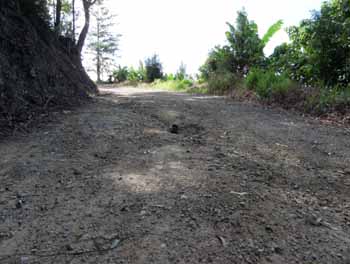
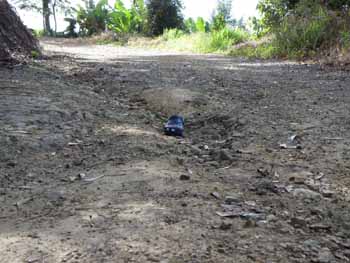
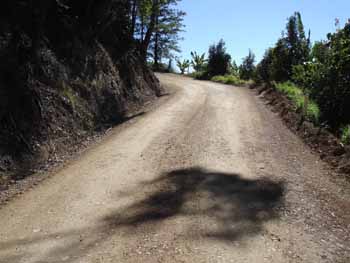
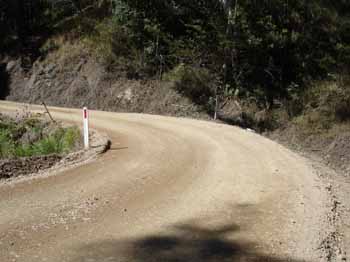
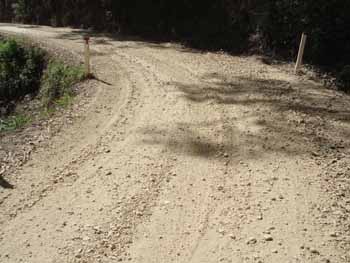

My partner and I have written to council on numerous occasions about the disgraceful state of this road. We have been told that all gravel roads in the Tweed shire are patrolled
regularly and are graded 3 times a year.
What actually happens is that on occasion (certainly less than 3 times a year) a road crew will spend some time clearing out the gutters and regrading. Only twice in the past ten years has the road been effectively resurfaced: one of those times was immediately prior to the WRC rally.
As I am also secretary for a landowning community responsible for 2km of private road elsewhere on the Tweed, and as my partner is responsible for the maintenance of all the roads on our 60Ha farm, we both have substantial practical knowledge of correct road maintenance and wish to inform the review that Tweed Shire Council (TSC) are most remiss in their maintenance programme on the gravel roads of the Tweed Shire.
We pay rates and this road is the only council service delivered to our home.
Immediately prior to the rally, however, TSC workers did such a good job that the road could easily have been tar sealed. We estimate they laid over 100 trucks full of excellent gravel on our road alone, spending no less than 3 weeks to water and roll this in. I have included photos of the state of the road surface prior to being graded for the rally, immediately after grading and prior to the rally and immediately after the rally.
When notified that a high speed rally was to be run on our road, my first concern was for the state of the road surface, as you can see that years of neglect had caused it to be little more than a goat track in places. I then realised that a contract to use this road as a stage in a gravel road rally for the next 10 – 20 years would mean that there would be no chance of having this road sealed in the foreseeable future.
I refer to Tweed Shire Council’s 2003 gravel roads rating review(4), where Cudgera Creek Road rated higher than several roads which have subsequently been sealed, and wish to point out that traffic estimates of 100-150 are far below what we are actually experiencing since the Cudgera interchange on the Yelgun - Chinderah Freeway opened in 2002 and the recent fad for GPS navigation aids in private cars took off.
Traffic has in fact increased since the 2000 estimates of 250+ movements cited in the gravel roads review, a fact substantiated in the TSC memo from July 2009(5). We are often pulled over by lost city folk scared out of their wits by finding themselves on this road, with it’s rough surface, blind corners and steep drop offs.
Public Safety Concerns
After my initial concern for the state of the road surface, I then started to research the link between motor sports and driving behaviours. I wish I hadn’t done this, as the results are quite simply alarming. There is a clear association between an interest in motor sports and an increase in speeding and risk taking, particularly amongst those under the age of 35. Crashes on the suburban roads around the Adelaide Grand Prix circuit increased by 35% after that event, and studies show this increase in road traffic accidents is repeated in other areas where a motor race has taken place.
One of the RRA employees (Operations Manager Bob Newman) asked me if I had found any research to prove that rallying was implicated in this increase in accidents: I put it to the Parliament that the burden of proof should be on organisations planning motor sports events on residential roads to prove that these events do not cause an increase in road traffic accidents, particularly as in this case the stage times are available on the internet.
Let me quote from Tranter and Warn’s 2004 study (6): “A problem with motor racing as a sport is that spectators who wish to emulate the behaviour of the motor racing drivers, can only emulate this behaviour on public roads. This then redistributes the burden of risk onto other road users who may happen to be in the vicinity…..” In another study in 2008 (7) the same authors state: “The results indicate a clear association between an interest in motor racing and the attitude that speeding is acceptable.”
I for one am not prepared to accept any increase in risk for myself, my family or our farm workers. I would also like to ask the NSW Parliament why are you funding the 'Speeding, no-one thinks big of you' campaign and at the same time funding motor car races and thereby encouraging speeding? This is not a rational use of taxpayer money.
I have attached the disclaimer that Repco Rally Australia asked spectators and participants to sign (8), and I ask the review chair and our elected representatives to read
this document carefully, with particular attention to the statement that: “Motor sport is
dangerous and accidents causing harm can and do happen and may happen to you”. You may also notice that the disclaimer asks them to acknowledge that the “risks associated with attending and participating in the event include the risk that you may suffer harm as a result of: motor vehicles (or parts of them) colliding with other motor vehicles, persons or property; acts of violence or other harmful acts committed by persons attending or participating in the event; and the failure or unsuitability of facilities (including grand-stands, fences and guard rails) to ensure the safety of persons or property at the event”.
This is in contradiction to what we were told at the public meeting in Murwillumbah on 7th February 2009, where RRA organisers assured us that spectator and driver safety was paramount. No wonder I was wary of this event, as by my reading the disclaimer shows that RRA actually expected violence amongst spectators and injury to persons and property. No wonder the residents of Kingscliff were angry at having the rally “service centre” placed in their midst. No wonder extra police personnel were seconded to the region.
Inappropriate Event for the Region
No Development Application eventuated, which is just as well for the rally organisers as it would have contravened many areas of the TSC charter, specifically council’s charter to “properly manage, develop, protect, restore, enhance and conserve the environment of the area for which it is responsible in a manner that is consistent with and promotes the principles of ecologically sustainable development; to bear in mind that it is the custodian and trustee of public assets and to effectively account for and manage the assets for which it is responsible and to have regard to the long term and cumulative effects of its decisions”.
Many local residents who are, like us, living the low carbon lifestyle of the future simply could not believe that anyone would be stupid enough to think that a high speed car rally is an appropriate event for a region recognised as biodiversity hotspot, with a burgeoning eco-tourism industry.
Regarding managing the assets of which the council is custodian, I am not convinced that the rally will have no effect on roads that would otherwise be sealed in the next 10-20
years(9). Who paid for the cost of road rehabilitation and in fact who paid for the hundreds of tonnes of excellent gravel used on the roads to make them safer for the rally drivers prior to this event? Ratepayers? And when will our gravel roads be sealed?
Public liability
At the Resident Safety Briefing only 6 days before our road was used for the rally, the Clerk of the Course still could not answer a simple question regarding who would be liable for injury or damage to property by spectators. RRA had $100 million public liability insurance, which to me seems woefully inadequate for such a dangerous event given that our own Farmers Market stall has to carry public liability insurance of $10 million and we only sell fresh fruit and vegetables picked by us the day before, a far less risky business than sponsoring high speed car races!
Tweed Shire Council officers were still trying to clarify this issue only weeks before the event(5) and it is highly likely that it will take a test case before we actually discover whether RRA has adequate insurance to cover all likely eventualities. Who is liable for deaths and injuries occurring during and particularly after this event, given that Repco Rally Australia asked participants and spectators to sign this extreme disclaimer? In particular, will TSC public liability cover the increase in road traffic accidents that research has shown we can expect after the event?
Infringement of Personal and Property Rights
As well as the issue of public safety the Review’s terms of reference include the impact of this event on the local community. As a community member I ask the Review to bear with me while I recount my experience of the WRC event.
It started in December 2008 when we returned from a holiday in SE Asia to discover a letter from Tweed Shire Council General Manager Mike Rayner on TSC letterhead inviting us to a meeting of residents who lived on roads which might (might) be used for the running of the 2009 WRC rally. The letter antedated the meeting by 2 weeks but both dates were in November and we had been out of the country all that month. I asked my neighbours if they knew what it was about and they had not received one of these letters. This seemed curious to me, as TSC has the record of rateable properties along the gravel roads proposed for the event hence Mr Rayner could easily have written to all affected landholders.
We are busy people so thought no more about it until (quite by chance) I noticed there was to be a public meeting about the RRA proposal in Murwillumbah on 7th February 2009. I went along to find out what exactly was being proposed. Garry Connelly from RRA spoke at that meeting. The point at which I became radicalised was when he stated that residents along the rally route had been surveyed and were “overwhelmingly in favour of the event”.
As we and our neighbours had not been surveyed and we alone have 1.5km of gravel road frontage to Cudgera Creek Road (and as Mr Rayner obviously had our address) I sat stunned by his willingness to lie in a public forum, then asked if I could please have a survey form to fill in. Many in the audience were shaking their heads at that particular
statement of his and after the meeting I talked with several people who, like ourselves,
lived along the route but had not been surveyed.
After the meeting I accompanied Bob Newman to the RRA office below the Council chambers and procured a survey form (attachment 4)(10). Bob told me that someone had surveyed residents on the western (Burringbar) end of our road but had not yet completed the survey on the eastern (Pottsville) end: I could see this was another lie as I noted a form in his folder with Bonomini’s name on it and they live to our east. Bob asked me if I wanted to fill the form in right then, but as we have a share farmer and a banana lessee (who employs several other locals) working on our farm, I asked him if I could send it in after they had all had a chance to have their say. Bob told me he’d come out to our place within the week to pick it up and that I did not have to send it in. He wrote down our contact details in his book.
After weeks of telephone calls, emails and so forth initiated by myself he finally came out to our place on 24th April, nearly 11 weeks after that public meeting. I had of course posted in the completed form prior to that.
My partner and I are valued members of the local community: him for his farming expertise and local knowledge, and myself for my professional ability as a GP. When I became involved in the No Rally Group I was approached by many people living along our road asking for details about road closures, details which they should have received from RRA. Naturally I gave them the contact details for RRA so they could direct their enquiries more appropriately. However the fact that many seemed not to have been contacted by the organisation led me to administer my own questionnaire to Cudgera Creek residents in July 200911. I started at Burringbar in the West and finished at Allambie Circuit in the East. 9 out of the 11 households visited on the gravel section were opposed to having the rally on our road and only 2 were in favour: this is a far cry from “overwhelmingly in favour”. 7 of these 11 had still not received a “Residents survey form” from RRA, only 2 months before the rally.
While my questionnaire was a flawed tool by research criteria, it is obvious from the results that the truth is far removed from Gary Connelly’s statements to the media and to the public meeting in February. I was not able to contact residents of 5 households on the
gravel section.
I apologise once again for the length and style of this submission, but believe it is only
by recounting the facts in all their detail that the Parliament can understand how a health professional like myself has become radicalised by the process which has occurred here. As an ethical person I abhor lies.
Funding Before Consent Given
At that public meeting in February 2009 we were told that a Development Application was to be submitted to council and that there would be the usual process of having it on exhibition for public comment. At that time I was not aware that Events NSW had already signed a contract with RRA, nor that both Events NSW and the TSC were advertising this event on their websites. Garry Connelly told the meeting that there was no “Plan B” should the DA not be approved and that RRA thought it most unusual that a “hallmark” event such as the WRC should be subjected to the DA process. Living in the tightly regulated Tweed Shire as we do, the audience laughed at his naivety.
When the DA promised for the end of March failed to appear by May, apparently the chair of the FIA contacted our Premier to ask for assurance that the event would take place as planned in September. One criticism many of us have of RRA is that they must be extremely incompetent administrators to have received office space and funding in September 2008 and yet not been able to lodge a DA by May 2009. More of their incompetence later.
Equity Issues: One Law for Them and Another for Us
I had a prior commitment that took me out of the region from April to the end of June and was horrified when I came back to read the Motor Sports (WRC) Bill 2009, as it overturned no less than 7 environmental protection laws and 5 laws pertaining to public safety. I am not an unreasonable person, but by enacting this Bill it would appear that the NSW Parliament acted extremely unwisely and cynically: one law for friends and allies of the various Ministers and another for the rest of us. It smacks of Animal Farm, a book the Minister would do well to read.
Why have planning laws if they can be overturned at the drop of a hat? What is to stop the general public fromdriving at high speed through our National Parks at the height of the breeding season? It makes a mockery of planning laws and indeed makes a mockery of the rule of law which keeps us all safe.
Environmental concerns specific to Cudgera Creek Road
I believe the No Rally Group submission (among others) will go into detail about environmental concerns about the staging of the WRC rally event in our region. However, I would like to make one additional point in this submission: while he was preparing the Biolink report I informed Dr Steve Phillips that we have twice sighted a Mitchell’s Rainforest Snail on Cudgera Creek Road – once in the 1980s and once in 2008. Both times were in September. Little is known about this animal other than that it has the highest conservation status of all: listed as critically endangered on the National Register of Threatened Species. It looks like a large snail, i.e: like yet another stone on our road to anyone driving at any speed.
We also informed Steve of koala sightings, there being a colony immediately above one of the hairpins about 300m along from our main farm entrance. His botanist, Kris Kupsch is aware of the presence of eleocarpus williamsianus ('Hairy Quandong') on our farm ~80m below the road, as he was the first to use GPS to locate it. There are 11 stands of this critically endangered tree in the entire world, all within a 20km radius of our farm.
It is extremely remiss of Dr Phillips to fail to include this extremely rare plant and
critically endangered invertebrate in his report, especially given that he knew of their
existence. The Giant Fern is also present less than 1km from Cudgera Creek Road on
a neighbours farm.
On those grounds alone I contacted the Federal Minister for the Environment, as my understanding was that he had the power to set conditions for the event if it might threaten endangered populations (as he did with the Homebush V8 development, for instance, which impacted on the Green and Golden Bell Frog – whose endangered status is in a lower conservation category than both the snail and the hairy quandong).
Experiences of a Resident on a Gravel Road: Dangerous Driving, Theft, Trespass and Intimidation
I have already mentioned years of inadequate gravel road maintenance. What I am now going to submit is details of what happened at our place on recce day 2nd September 2009 and rally day 4th September 2009. We are ratepayers, we vote and pay taxes like everyone else and the four families who earn a living from our farm surely have a right to earn their livelihood.
On the evening of 1st September, aware the recce was speed limited to 60km/h and would have its first pass at 0830 the next morning, I placed some rally protest signs at the top of our driveway. They were painted on corrugated iron sheets roughly 2.4m in length (see photo below of one of them).

Early Wednesday we tied a banner to our bottom gate. Rally recce started at 0830, with 3 batches of around 15 cars driving at reasonably slow speeds for the first pass. As Wednesday is also picking and packing day for the Byron Farmers Market and as we had been having dry weather, we needed to constantly drive down to the veggie patch to refuel and check on our irrigation pump. This meant that my partner and I could not avoid making several trips along the 1.1km stretch of Cudgera Creek Road between our top driveway and the bottom gate by which we access the market garden at the bottom of our farm.
I understand it would have been frustrating for the rally car drivers to get stuck behind our lumbering 4WD tractor on our narrow road, but we had made the Operations Manager aware we would be doing this (as we do every Monday and Wednesday) and had been told it was OK to do go about our usual premarket business that day. My son had borrowed my car the day before so when he returned it I had to drive him home - this was around 1230. I'd waited until then as I thought most of the recce cars would have made their second pass, and we had to catch the P.O before it closed at 1300, as the mail is collected before it re-opens at 1330 and I had no stamps.
At the top of the driveway I realised someone had stolen our signs between when I checked at 1030 and when we drove out at1230. I decided to drive down and check that the banner on the bottom gate had not been stolen too. Just as I was getting back in my car my partner came back up the hill for lunch, closely followed by a water tanker which had no doubt been delivering water to neighbours (as the road showed no signs of having been watered).
I was standing on the hairpin corner at our top drive and I could see a rally car approaching at speed down the hill towards me. Out of his vision around the corner was my partner driving the tractor up towards our driveway. I was extremely concerned that the rally car was going to smash into my partner as there was nowhere for the tractor to get off the road, so I flagged the car down. Initially I didn't think he was going to stop but luckily he realised I was serious so he did – he came to a halt behind my car facing the
outside of the hairpin at right angles to the road, with his tail halfway across it (it’s about 2.5 cars wide just on the corner). My partner drove past him to turn into our drive, I was in front of him facing down the road towards the bottom gate. The water
tank driver continued past heading towards Burringbar.
As we were running late for the post office and I did not want to risk a broken windscreen from the rally driver (car number 4, Jarri Latvala) speeding past us, and as he was making heavy weather of getting back on track due to the loose gravel on the outside edge of that corner, my son and I headed off down to our bottom gate to see if the banner there had also been stolen - it had.
On the way down the hill towards our bottom gate Jarri caught up with us and was obviously keen to overtake, however it is not possible for the first 400m or so as the road is so twisty and narrow. As the road opened out I was about to indicate to pull over to the left when he overtook me on the INSIDE (left). Fortunately I swerved back onto the road to allow him to do this or he would have collected the left side of my car.
After checking the bottom gate I headed back towards Burringbar to catch the P.O. and report the theft and the dangerous driving to the marshals at the bottom of the road - they were stationed at the Burringbar quarry, about 3km back towards Burringbar. I met my partner heading back down the road on the tractor as he’d left something back down on the flat and stopped to discuss what we were doing – the usual sight on a rural road of a person in a car talking with a person on a tractor. I also warned him to watch out in case one of the 4 or so rally recce cars behind him decided to do something dangerous like overtake on the left, then headed off to report the stolen signs and dangerous driving to the marshals. They told me the only vehicle capable of carrying 2m corrugated iron they'd seen that day was a white truck with yellow sides – which sounded to me like a TSC truck we’d seen on the road earlier that day.
When I got back home about an hour later after taking my son home I discovered that the car which was the second car after Jarri had also overtaken my partner on the left at the point where the road widened enough to enable him to pull over out of its way. As suggested by the marshals, I rang and reported both these episodes to a volunteer at the Rally Hotline. I also rang the police to report the stolen signs – they suggested I ring council to see if they had been removed by a council officer and would not take my report until I had done this. After being put on hold at TSC for a lengthy period I hung up and did not pursue the matter of the stolen signs any further.
Later that day as I walked around our road boundary to ensure no other harm had been done, I noticed that the smooth surface council had spent nearly 3 weeks providing us with only the previous month was now in tatters - marble sized jagged gravel and powdered dust. It looked like photo 5, worse in some places.
SUMMARY OF RECCE DAY 2ND SEPTEMBER
2 cars illegally overtook on the left, three 2.4m lengths of corrugated iron and one handpainted banner stolen. Thefts reported to police who failed to record them and illegal driving reported to “Rally Central”. No action taken on illegal driving as those drivers continued in the competition. Road surface ruined, and partner, self and son placed at risk by dangerous and illegal driving.
On rally day, Friday September 4th, we got up early to check the goats would be fine
herded into their shed for the day to keep them safe. We also watered in a bit of blood and bone and dynamic lifter around our driveways to discourage spectators from trying to set up camp on our place. We did this as by now we had little trust in the organisational ability of RRA and doubted their ability to keep spectators off our property.
Our 2 main driveways on the farm are situated on the outside edge of hairpin bends, below the road and directly facing the oncoming vehicles, so according to the Clerk of the Course instructions given at the public meeting the previous Saturday we knew no-one should stand there as they would be a) directly in front of the cars as they raced down the hill and b) at risk of injury if a car came off the road or sprayed gravel and rocks over them. We had decided that smell might discourage trespassing spectators, and the plants at both driveways could probably do with being fertilised anyway.
When I drove down to Burringbar to pick up a few groceries at about 0830 I noticed a few young men camped out on the spur above our top driveway, sitting on eskies with beer in hands. They had parked their car in our neighbour's bananas so when I got home and saw 4 'crowd control' police and a highway patrol car at the top of our drive I reported the fact that the young men were trespassing on that spur of land, as it is owned by a couple who don't live there and we don't have their contact number. I also informed them that our neighbour up the hill probably didn't know she had a car parked on her place. Guests of our banana farmers, who had organised to have a BBQ in the bananas to watch the race, had already started arriving before 9am.
My son and a carload of his friends had followed me up the hill from Burringbar and all in all by the time the road was closed to the general public we had about 15 guests on our place. I explained the importance of not standing below the road, on the outside of hairpin bends and in front of oncoming vehicles to each one of our visitors. Several of them elected to watch the rally from the spur above our driveway and I informed them this would be trespassing. At that stage we had 7 police officers at the top of our driveway and I explained the safety issues to them as well as they were standing in the 'danger zone'.
Around 1015 we drove down to the bottom gate to check no-one was trespassing on our land down there. There was no-one there so we came home, where we found a council truck shovelling the manure behind the two large rocks which delineate our top boundary. There were also three people bearing official WRC media tags who wanted to park their car on our place. We politely informed them that we had no intention to allow anyone we didn't know onto our place and that Rally Australia could have and should have asked us first. They tried to barter the fact they'd give the protest international internet cover if we let them park there but as an official NRG spokesperson with plenty of air time I didn't feel we needed it so asked them to leave.
I also explained that at the public meeting the previous week I had made it very clear to the Clerk of the Course that no-one other than our guests and the police would be allowed onto our place and that, in my opinion, Rally Australia was extremely disorganised not to have organised a parking place for them and that I felt they (RRA) couldn't organise a piss-up at a barbie: this brought a smile to their faces and the faces of our (by now resident) police officers. The police officers escorted them away to park elsewhere.
We then went home to cook a big breakfast as it felt it had already been a long day even though the rally had not even started. My partner walked up to the top of the drive to check on the situation while I was making the coffee but when he got there he discovered a race marshal trying to park his car at the banana packing shed.
As previously stated, I had made it quite clear to the Clerk of the Course at the safety briefing that the only people allowed onto our farm on that day were to be our guests and the police. She had not sought permission for marshals to park their vehicles on our place and I had assumed the marshals would be bussed in by the organisation.
By this stage it was quite evident that the police were not going to assist us to maintain
order, so my partner came back to the house and drove the tractor to the top of the drive in order to block it so no-one else could trespass onto our place. By then the road had been closed to everyone except people on rally business.
It was around 1040 and the race was expected to come through shortly after 1100. When my partner returned from parking the tractor I had just finished brewing the coffee when the 15 y.o. son of the banana farmer came down to the house and told us that the police wanted him to move his tractor. I asked him to let them know we'd be up when we'd had breakfast - thinking it rather rude and extremely unprofessional of the police to
send a minor with that request.
About 10 minutes later 3 policemen walked down to the house (which is about 250m from the top of the drive) and the first thing that one of them said was: "I am going to have to arrest you and charge you with intimidation" to my partner. We had assumed they'd be asking us to move the tractor so were naturally quite taken aback by this. It turned out that the marshal had taken offence to him parking the tractor close to where he'd set up his seat (on our land).
Fortunately one of the policemen was a Kingscliff local and defused the situation by telling us he just wanted to find out what had happened when my partner parked the tractor. Apparently his foot had slipped off the clutch pedal as he switched the engine off and the marshal wrongly assumed he'd intentionally made the tractor lurch towards him (even though the driveway is about 5m west of the place the marshal was sitting). We settled the issue by the police parking their vehicles to block our drive from further trespass. They told us they would be staying for the rally as they were obviously concerned about the increasing numbers of people crowding onto the narrow spur above our driveway – as you can see from the photo below it had become an unofficial spectator point, something we had been repeatedly assured would not be allowed to happen.
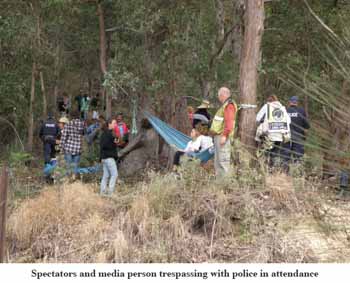
As the police were leaving to sort this new parking arrangement out, the one who spoke first told me: “What are we supposed to expect, you have protest signs at the top of the driveway, potential missiles (which turned out to be the fertiliser which I certainly had no intention of touching, let alone throwing) and you’re wearing a Tshirt with protest slogans".
I politely informed him that I was involved in police liaison and that NRG had a written agreement to be co-operative with reasonable police requests and that our farm was not a registered protest site. He said no more after he heard I'd personally met Michael Kenny, however it raised doubts in my mind about whether the imported crowd control police had had any briefing whatsoever about our peaceful protest protocol.
The two rally marshals who had set up near the top of the driveway had set their seats
as shown in the photo below: on the outside of a corner, below the road and directly facing oncoming rally cars.
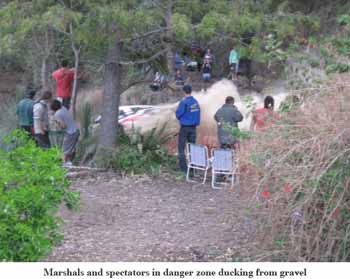
I did not want to argue with the marshals as I was not sure I could retain my composure as I was feeling extremely stressed about how we were going to deal with all these people on our land and on the spur opposite who might be at risk of injury.
To understand how I feel you must appreciate that as a medical practitioner I am obliged to render assistance should anyone be injured and having seen WRC footage in which spectators were skittled by rally cars I had a sense of foreboding at what could possibly happen on our land if people persisted in disobeying the safety instructions of the Clerk of the Course.
In order not to assume negligence on their part, I would hope that the marshals had not received as comprehensive a safety briefing as was given to the general public, and that they had not heard Garry Connelly's claims about public safety at the public meeting in February.
I had contacted Harold Carter from CASA 2 weeks before the rally to establish a 'no go'
zone over our farm. One of our objections to this event is the unreasonable burden it places on rural residents to safeguard the welfare of their livestock and their livelihood. We had been intending to breed our small flock of goats last year, but when we realised they would be kidding at the same time as the rally came through we decided not to risk spontaneous abortion and failure of bonding due to stress caused by the noise of the rally cars and low-flying helicopters.
When he visited the farm in April, Bob Newman had informed us that the official FIA media helicopters had gyroscope cameras which could zoom in from above the regulation 500’ and that they would have no need to fly lower than that. He also informed us (when pressed for an answer) that there would be no compensation for lost productivity. So after contacting Mr Carter to ensure that the RRA pilots knew where we were and that we had asked for the usual 500’ minimum height of flight in a rural area I was very upset to see how low the helicopters actually flew. As a result I spent most of the rally day in the goat shed calming them down to ensure they did not escape and put themselves and the rally drivers at risk.
Some of the photographs included in this submission were taken by a friend who visited us on rally day expressly to bear witness to the event. His name is Andy Yeomans and he has made a separate submission containing more photographs, including shots of children crossing the road between rally cars. You will notice that some shots are taken from a position where he has put himself in the “danger zone”. I would like to assure the review chair and the NSW Parliament that he did this fully informed of the risks and in full view of the marshals and police who made no attempt to stop him.
As the only NRG spokesperson available to speak that day (the others being situated in places with no mobile phone coverage), during the course of the afternoon of 4th September I was kept busy fielding calls about an incident at Byrrill Creek where that stage was cancelled due to a concern for driver safety. Various reports I had from DS Sheehan, NRG members and the media itself (ABC local radio, NBN News and the Tweed Daily News amongst others) were that there had been a report of a rock or rocks thrown at a rally car or cars, that a fence had been cut and cows let out onto the road and that rocks and sticks had been placed on the road.
As it now transpires, none of this happened and no charges have been laid. I had extreme difficulty fielding these calls from the goat shed with the backfiring of rally cars and chopping of helicopter rotors in the background adding to the already crackly mobile phone reception we have up on the farm. I was widely quoted from my ABC radio interview as saying that: “It is highly regrettable that anybody would stoop to violence, however I can understand where it comes from. It comes from that sense of people being disempowered: what are they to do?”
This statement, which in no way condones violence, later backfired on the group as it was considered too mild mannered a response to the claims that ‘drivers were pelted with stones’ (Reuters). Online prorally fora threatened rocks thrown at protestors.
What is highly regrettable is that Superintendent Michael Kenny is quoted in the New York Times of 4th September as saying: “The protesters involved in this rock-throwing incident have shown total disregard for the safety of competitors and officials involved in today’s stage of the event.” No reference to the fact it was at best a rumour hence should have been reported as “alleged”. Ultimately the most regrettable thing of all is that this event ever came to our peaceful region.
SUMMARY OF RALLY DAY 4TH SEPTEMBER
Unofficial spectator point established without permission of owner of property. Police notified of this and no action taken. Intimidation by police of farmer protecting property from invasion by unknown people. Marshals disobeying instructions of Clerk of the Course. Children crossing road between rally cars. Landowners the only ones attempting to maintain public safety. WRC media helicopters flying below agreed 500’ limit. High ranking police lied to the media.
Police Bias and Dangerous Driving
As then secretary of the No Rally Group and as one of their police and media liaison people, at around 0930 on Saturday 5th September I joined the planned protest by the
Murwillumbah – Kyogle Road at Barkers Vale Primary School. I stood behind the fog line as previously arranged with the police and crooked my little finger at rally car drivers and through traffic alike. On one occasion I noticed a protestor (not anyone I had previously met through NRG) using the wrong finger. I explained which finger we were to use in order to highlight the low opinion we have of speeding and he complied.
At one stage bare bottoms were exposed to lighten the mood: I wore boxer shorts with the slogan “NO RALLY” painted on them.
I continued to receive numerous calls from the media about the alleged rock throwing incident at Byrrill Creek the previous day and asked DS Sheehan if he could clarify what had happened. He told us that the matter was under investigation and it was his understanding that a marshal had reported the incident and that there was video evidence.
I witnessed several incidents in which vehicles travelling the Murwillumbah – Kyogle road swerved at protestors. On one occasions a vehicle span its wheels as it took off towards Kyogle. I rang DS Sheehan to inform him of one incident which occurred before he arrived from Murwillumbah, asking him to send police to locate a maroon 4WD heading towards Murwillumbah which had swerved at a protestor on the northern side of the road. This 4WD had QLD plates and had children in it. When I asked him if he could get the police to locate it, DS Sheehan assured me that he was the police so it was in his power to apprehend the driver: when he later arrived at the school he told us that he had not seen the vehicle.
We heard that the hall we had planned to use as a marshalling point for our protest at
Green Pigeon was being used for a memorial service and that some members of NRG and 7th Generation had been threatened out there, so I and several others decided to drive out there to cancel the protest at that site as we were unable to raise anyone by phone (reception is poor at best in this region and although I carry a 'farmers phone'
few of our members were as well equipped).
Carolyn Latham accompanied me as we thought it safest to travel in pairs after having
witnessed the damgerous driving of rally spectators earlier that day. We had some difficulty leaving the carpark outside the Lillifield Community Centre as the crowd control police had crossed the road and were standing in a line facing the protestors. I explained to them why I needed to get through and they let us through but apparently other cars had difficulty leaving (I believe the details are in the police report).
On the way to Green Pigeon Carolyn and I witnessed several episodes of dangerous
driving where we were overtaken on double white lines as we neared blind corners. She has further details of what happened when she tried to get these followed up by police in her own submission to the review. Because I was planning to stay at Lillifield that night I was driving our farm ute which has a canopy on the back - a comfortable place to roll out the swag. Unfortunately it has a high mileage diesel engine and is slow on hills, which may have caused some impatience in the following traffic but there were few places to pull off and the road is narrow and tortuous: I did what I could to get out of the way of following vehicles but was for the most part stymied by the road. Most corners had a recommended speed of 35 – 45 km/h.
Elizabeth and Megan Jack have made separate submissions about dangerous driving they witnessed during that trip. We were extremely frightened by being overtaken as we approached blind corners, given that if a car did appear coming the other way there was really nowhere to get off the road, as you can see from the photo below.
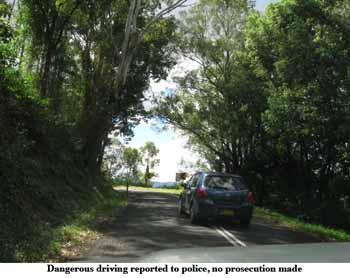
About 2 km from Kyogle on the road out to Green Pigeon we met protestors travelling the other way and stopped to arrange who would go out to Green Pigeon to cancel the protest there. While we were discussing this by the side of the road, a couple of police vehicles stopped to ask what we were doing. They appeared to think we were planning a roadblock so we explained the situation. I later heard that the police were pleased we had acted responsibly to ensure no clashes with the people at the memorial service at the Green Pigeon hall.
Later that evening I spent some time with NRG media spokesperson Andrea Vickers and 7th Generation media spokesperson Peter Lanyon preparing a media release. As we wished to be 100% sure of our facts and DS Sheehan and Superintendent Michael Kenny were unavailable we contacted another of the officers we had met during prerally liaisons (I can’t remember his name – possibly Craig Newman?) to ask for clarification on the rock throwing story which had made headlines internationally. We were told a marshal had video footage of a rock or rocks being thrown at a rally car but that the footage had not been secured.
It now transpires (a stated by Acting Area Commander Loy in Murwillumbah on 3rd February 2010) that no charges were laid because no rocks were thrown: “It didn’t happen, end of story”.
In my opinion the police did a lot of harm to public safety by failing to highlight that this was an allegation. If they do not formally apologise for the harm done there should be an Inquiry. As rally spectators assumed that actual rocks had been thrown at the drivers, they reacted by driving dangerously and throwing missiles at peaceful protestors who were doing nothing other than exercising their right to creative free speech. Ultimately the police have a hard enough job without allowing rumours to spread which increase the risk to public safety.
I participated in the protest at Uki on Sunday 6th September and at one stage spoke
through the PA belonging to Graeme Dunstan of the Peacebus. Graeme is a Northern Rivers man who is not a member of NRG or 7th Generation but wished to help by providing his PA system so we could broadcast our reasons for the protest. The police behaved most professionally at this protest location, although when I first arrived there they had been unwilling to let us set up where planned. They allowed a person dressed in a kangaroo costume to lie on the pedestrian crossing and did not take offence at irrelevant and potentially antagonising statements from Mr Dunstan.
The final protest site was the side of the road opposite what we refer to as the 'Pit Stop' at the Cudgen Leagues club. When I arrived there I noted that we had been corralled behind a plastic mesh fence on the southern side of ?? road, and that crowd control police were across the road from us. The situation turned nasty after the end of the rally though, as people driving down the road slowed down to yell abuse and returned our “little pinkies” with a much more inappropriate finger. One friend was subjected to eggs being thrown at her, another fellow had sour milk thrown at him and yet others had beer cans being thrown at them. There was no evidence of an RBT presence (unlike the Byron Blues Festival or other major regional events) and police officers including DS Sheehan appeared reluctant to do anything about the missiles being thrown at us in spite of us giving them the details of the vehicles concerned.
Over the next couple of days my previously high opinion of the NSW Police Force slipped still further when I received a bizarre telephone call from Superintendent Kenny in which he asked me what colour councillor Katie Milne’s car was. Apparently a purple vehicle had been seen by council workers depositing frozen animals on Clothiers Creek Road. This was the second reference he had made to frozen roadkill, the first being during one of our pre-rally police liaison meetings. I did not know what colour councillor Milne’s car is and told him this. I asked him when we were to have the post-rally debrief with the police and was told this phone call was it. I explained that my understanding (which I double-checked with Mary Willis from 7th Generation as being correct) was that we were to meet face-to-face as we had in August. I was due to leave for a one month locum interstate that Sunday and made it clear it would be preferable to meet before then while it was all fresh in our minds.
On Tuesday 8th September the No Rally Group met as previously planned to discuss what had worked and what hadn’t during the protests. We met immediately prior to the TSC council meeting which we adjourned to at around 1715 as some of us had booked to speak there at 'Community Access'. During the NRG meeting, at about 1700, I received another telephone call from Superintendent Michael Kenny in which he told me that photographic evidence had been secured regarding the rock throwing incident at Byrrill Creek. As residents of that road were at our meeting I asked them if they had seen any such behaviour – they hadn’t. As previously stated, this was also far from the truth as subsequent events have shown that the whole rock-throwing allegation was at best a rumour and at worst an attempt to discredit our grass roots organisation and sabotage the police liaison process and cause rifts in the community.
Councillor Youngblutt lied to us at that council meeting: he said that the police had informed him that they not only had photos but also had names and arrests were being made as the meeting was in progress. This same councillor is on record as referring to the voters of the Tweed as “morons” but only just scraped in at the elections in 2008 – a fact which voters of the Tweed believe belies his own statement about us being a pack of morons. As he made the outrageous statement about arrests being made only about 20 minutes after I had spoken with Superintendent Kenny I knew it to be a lie, however Community Access etiquette prevented me from stating this.
One final point I wish to make: if the NSW Government intended to unite a community against it then it has done an excellent job. Personally, as someone who avoids conflict by choice, I am appalled at how effectively the Government has disenfranchised the community and feel obliged to point out that this was an exceptionally stupid thing to do. When the one stage which was cancelled was the one about which all sorts of rumours of illegal behaviour made headlines, it sends the message that the police liaison process does not work and actually encourages the very same unlawful behaviour we all sought to avoid.
SUMMARY AND RECOMMENDATIONS
This event was staged in the wrong place – this is a region of high conservation values which should be recognized as such and treated accordingly. Our eco-tourism status is at risk, as are our unique and endangered flora and fauna. This event must not come back to the Northern Rivers
· Events NSW should have researched what events are appropriate to our region
· If Events NSW would have been accountable to the people of NSW we would have had an independent cost-benefit analysis. It should therefore be made accountable as it is our public money they are spending
· In order to assure voters of transparency and impartiality we need an independent cost-benefit analysis on this event done now
· This event has been extremely damaging to community cohesion and social goodwill
· People in authority (police officers and local councillors) have lost credibility
with the community as they have lied to us
· The NSW State government has radicalised and united a group of people who have the best interests of this region at heart and we intend to continue to work together
· If this event does comes back to the Northern Rivers region expect more opposition now the extent of the lies and misinformation has been exposed
· If it’s too hard to get out of the contract then simply take this event somewhere where it is wanted. See the debate about the WRC Bill (in Hansard June 2009) for ideas about suitable areas: several MPs actually asked for it to be given to their electorates
For the record: at the public meeting organised for the review in Murwillumbah on 3rd February, of roughly 110 attendees 95 were against the rally, 7 for and the others failed to tick the box. It was inequitable that Mr Cahill asked for one pro rally speaker for every no rally speaker. If this event was such an overwhelming success, where were its supporters?
Finally, I would like to quote from Barack Obama’s book “The Audacity of Hope”, written during his first two years as a US senator: “In a democracy the most important office is the office of citizen”(12). We get to vote for our representatives and we plan to hold them accountable for their actions.
Dr Fiona McCormick
B.Med, DRANZCOG, FRACGP
References:
1. ABS 2006 Census of Population and Housing, CAT 2068.0 Age by sex, Tweed Local Government Area
2. Road Traffic Crashes in NSW 2007. Published by the NSW Centre for Roads Safety
3. RTA leaflet on Crashes involving Young Drivers
4. Report of the 2003 Gravel Roads Review, published in the minutes of TSC meeting 7 May 2003 pp 156 – 172 (Attachment 1)
5. Tweed Shire Council memo July 2009 (Attachment 2)
6. Warn, J. R., Tranter, P. J. and Kingham, S. (2004) Fast and Furious 3: Illegal street racing, sensation seeking and risky driving behaviours in New Zealand . 27th Australasian Transport Research Forum , Adelaide , 29 September – 1 October 2004.
7. Relationships between interest in motor racing and driver attitudes and behaviour amongst mature drivers: An Australian case study Paul Tranter, JamesWarn: Accident Analysis and Prevention 40 (2008), pp 1683–1689
8. Go to the official Repco Rally Australia website, under the “Spectators” menu click on the “Official Tour” drop down box: http://rallyaustralia.com/wpcontent/ uploads/2009_rally_aus_tour_brochure.pdf and you will find this disclaimer is page 5 Accessed 15th February 2010 (Attachment 3)
9. Statement by General Manager of TSC Mike Rayner in minutes of TSC meeting 17th March 2009, p 92
10. Attachment 4 – Resident Survey form
11. Attachment 5 – questionnaire administered to Cudgera Creek residents in July 2009
12. Barack Obama: “The Audacity of Hope” Text Publishing Company 2006, p 135
Recent comments